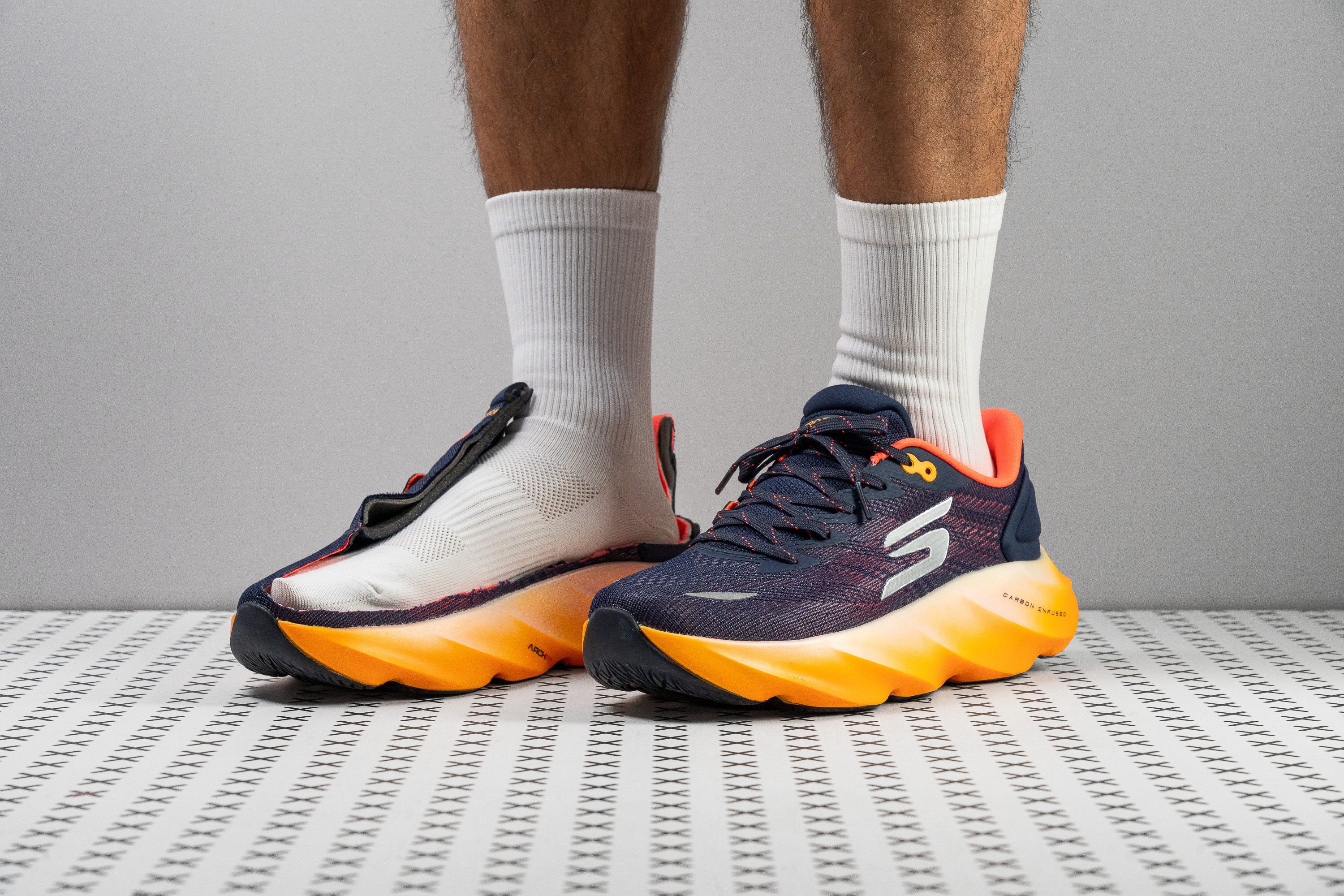Nuestra conclusión
Pros
- Muy buena amortiguación
- Diseño único y atrevido
- Buen retorno de energía para ser espuma EVA
- Se sienten blanditas y mullidas bajo los pies
- Rocker que mejora las transiciones
- Estables a pesar de lo alta que es su amortiguación
- El caucho GoodYear ofrece un agarre sólido
- Buena durabilidad
- Precio justo
Contras
- Más pesadas que la mayoría de sus competidoras
- Ajuste estrecho con una parte delantera con poco volumen vertical
- El rocker tan exagerado que tienen puede no sentirse natural
Veredicto de los usuarios
- Top 4% entre Zapatillas de running para asfalto
- Top 3% entre zapatillas de running neutras
- Top 8% más vendidas zapatillas de running
Comparativa
Las zapatillas de running más parecidas
+ + Añadir unas zapatillas | |||||
|---|---|---|---|---|---|
| Puntuación global | 92 Excelentes | 87 Notables | 85 Buenas | 88 Notables | |
| Precio | 200 € | 190 € | 160 € | 230 € | |
| Pace | Correr a diario | Correr a diario | Correr a diario | Correr a diario | |
| Absorción de impactos | Alta | Alta | Alta | Alta | |
| Retorno de energía | Moderado | Bajo | Bajo | Moderado | |
| Tracción | Alta | Alta | Alta | Alta | |
| Arch support | Neutral | Neutral | Neutral | Neutral | |
| Peso laboratorio Peso marca | 11.4 oz / 322g | 9.8 oz / 278g 9.9 oz / 280g | 9.1 oz / 258g 9.3 oz / 265g | 11.5 oz / 326g 12.4 oz / 351g | |
| Drop laboratorio Drop marca | 8.8 mm 6.0 mm | 7.2 mm 5.0 mm | 8.3 mm 10.0 mm | 8.8 mm 10.0 mm | |
| Técnica de carrera | TalónMedio/antepié | Medio/antepié | TalónMedio/antepié | TalónMedio/antepié | |
| Talla | Tallan bien | Tallan un poquito pequeño | - | - | |
| Rigidez de la mediasuela | Blanda | Blanda | Blanda | Blanda | |
| Diferencia de la rigidez de la mediasuela en frío | Normal | Grande | Normal | Pequeña | |
| Durabilidad de la parte delantera | Decente | Decente | Decente | Decente | |
| Durabilidad del acolchado del talón | Alta | Alta | Alta | Alta | |
| Durabilidad de la suela exterior | Buena | Buena | Decente | Buena | |
| Transpirabilidad | Media | Media | Media | Media | |
| Anchura / ajuste | Media | Estrecha | Media | Media | |
| Anchura de la parte delantera | Estrecha | Media | Ancha | Estrecha | |
| Flexibilidad | Moderada | Rígida | Moderada | Rígida | |
| Rigidez torsional | Rígidas | Rígidas | Rígidas | Rígidas | |
| Rigidez del contrafuerte del talón | Rígido | Rígido | Rígido | Rígido | |
| Rocker | ✗ | ✗ | ✗ | ✓ | |
| Talón laboratorio Talón marca | 41.7 mm 42.0 mm | 41.9 mm 38.0 mm | 37.5 mm 39.0 mm | 50.1 mm 55.0 mm | |
| Antepié laboratorio Antepié marca | 32.9 mm 36.0 mm | 34.7 mm 33.0 mm | 29.2 mm 29.0 mm | 41.3 mm 45.0 mm | |
| Anchuras disponibles | EstándarAncho | Estándar | EstándarAncho | Estándar | |
| Orthotic friendly | ✓ | ✓ | ✓ | ✓ | |
| Estación | Todas las estaciones | Todas las estaciones | Todas las estaciones | Todas las estaciones | |
| Removable insole | ✓ | ✓ | ✓ | ✓ | |
| Clasificación | #9 Top 3% | #153 Top 41% | #220 41% inferior | #133 Top 36% | |
| Popularidad | #30 Top 8% | #285 24% inferior | #130 Top 35% | #4 Top 2% |
Quién debería comprárselas
Las Skechers Aero Burst son como un soplo de aire fresco para esta marca, así que se han ganado a pulso tener su propia serie. Después de analizarlas, nos parecen ideales para:
- Los runners que están buscando unas zapatillas comodísimas y con un montón de espuma.
- Los fans de los modelos de running modernos que tienen diseños protagonizados por el rocker (sobre todo los talonadores).
- Cualquiera que esté buscando un par específicamente para las distancias largas por un precio razonable, teniendo en cuenta cómo está el mercado hoy en día y las posibles características.
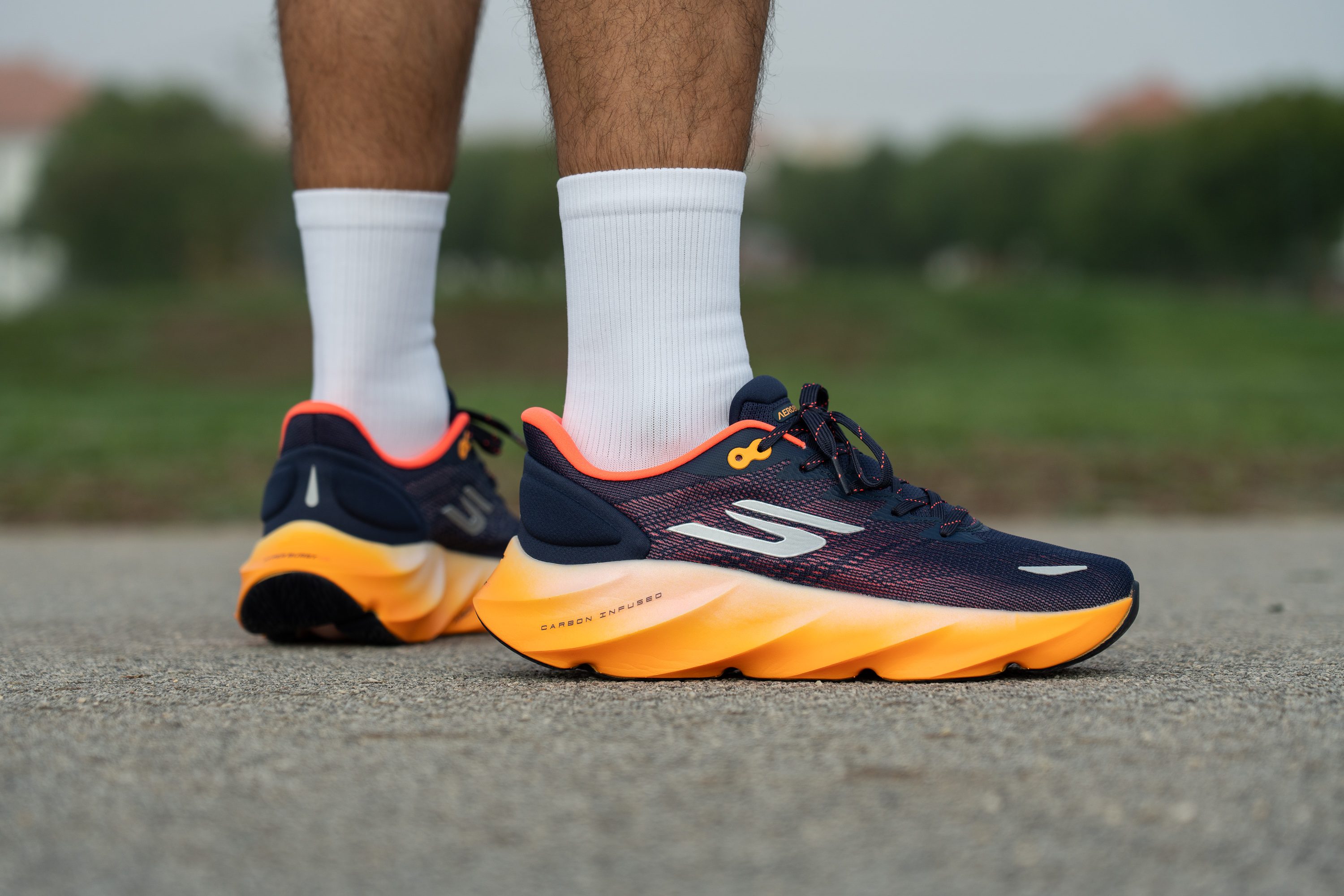
Quién NO debería comprárselas
Creemos que las Aero Burst no son la mejor opción para los corredores con pies anchos o voluminosos. En nuestro laboratorio, descubrimos que su parte delantera es baja y estrecha, así que, en nuestra opinión, las personas que necesiten un espacio extra para los dedos a lo mejor terminan sintiéndose incómodas o con rozaduras. Si estás buscando un ajuste un poco más amplio, las Adidas Ultraboost 5 son una buena alternativa.
Personalmente, creemos que el peso es el punto negativo más potente de las Aero Burst. Si estás buscando algo más ligero, te recomendamos las ASICS Novablast 5, que te ofrecen la misma mediasuela maximalista en un formato mucho menos voluminoso; o las Nike Vomero Plus, que equilibran una amortiguación blanda con una estructura más ligera.
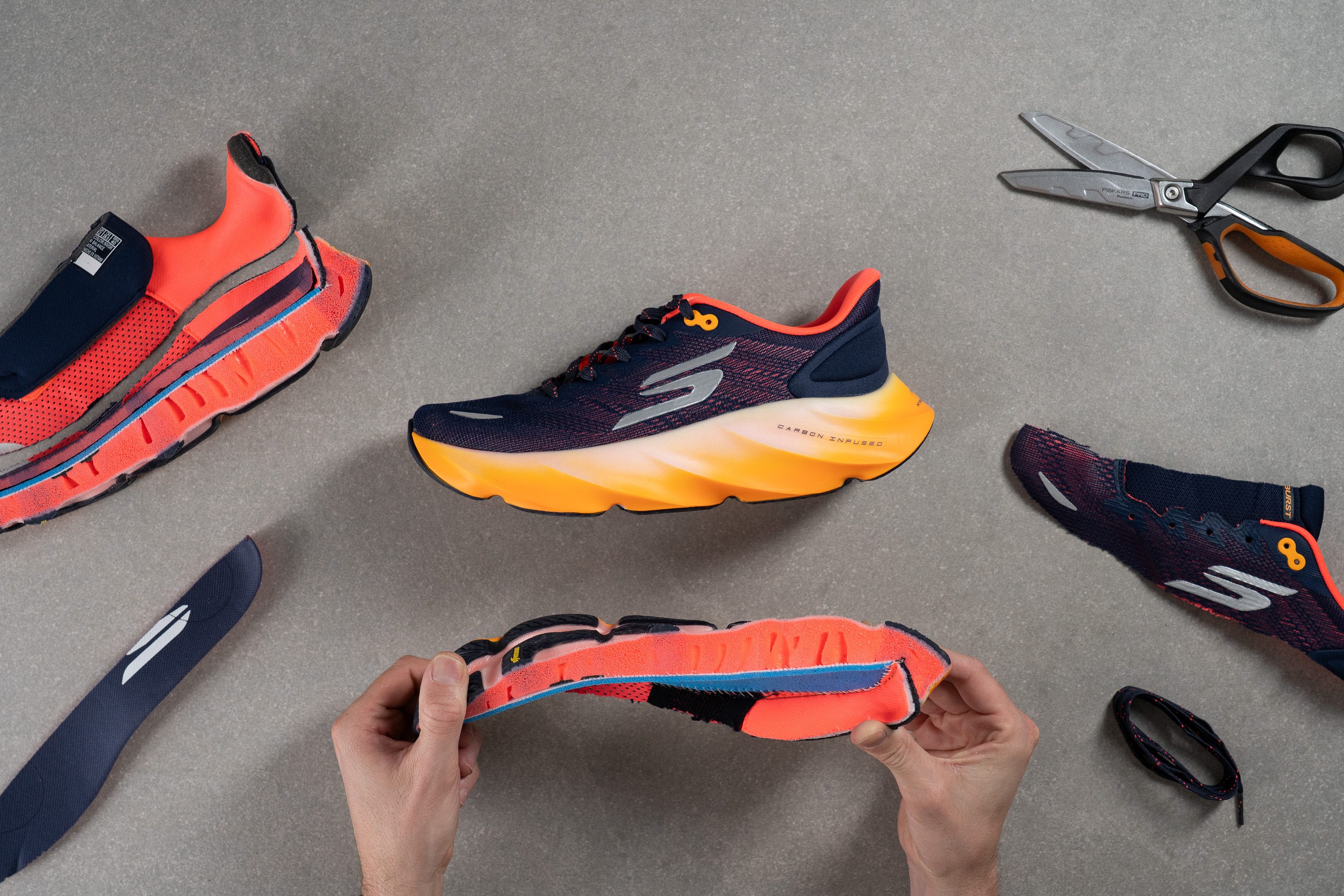
Amortiguación
Shock absorption
Con solo echarles un ojo a las Aero Burst, todo el mundo puede adivinar que son unas gigantonas, ya que su mediasuela es altísima. Y otra cosa que es alta es su absorción de impactos, que se encargó de proteger nuestras articulaciones en cada paso.
Cuando las analizamos en nuestra máquina, marcó 145 SA en el talón y 120 SA en el antepié. Ambos resultados superan fácilmente la media de nuestro laboratorio, lo que confirma que los atletas que quieren usar las Aero Burst para enfrentarse a distancias largas tienen garantizada una amortiguación confiable.
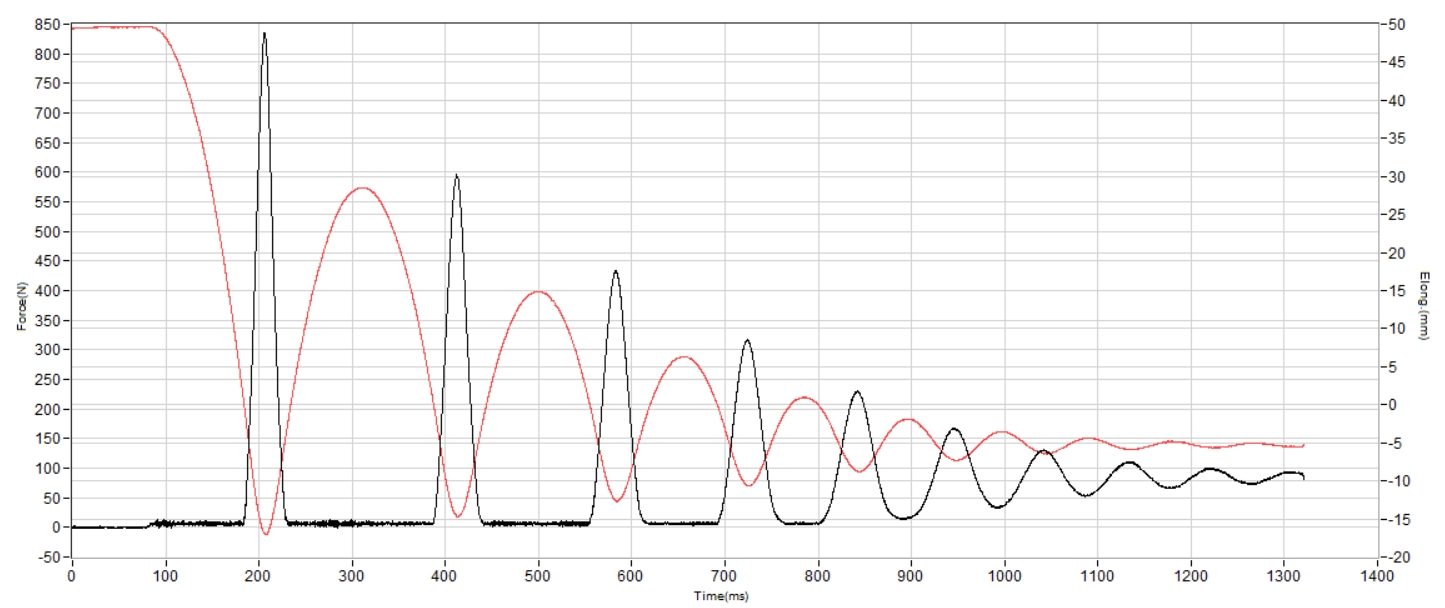
| Aero Burst | 145 SA |
| Media | 129 SA |
Energy return
La espuma Hyperburst Ice de Skechers está hecha de EVA supercrítica, así que no nos esperábamos un resultado a la altura de las superzapatillas que hemos analizado en nuestra prueba de retorno de energía. Pero bueno, para ser justos con este modelo, la verdad es que nos quedamos contentos cuando terminamos la prueba.
Un 60,3 % en el talón y un sólido 64,9 % en el antepié son unos buenos resultados, ya que confirman que las Aero Burst son unas compañeras excelentes para las tiradas diarias, o incluso para los entrenamientos de fin de semana de 1 hora y media o hasta 2. ¿Que por qué? ¡Pues porque vienen cargadas de amortiguación y tienen un buen rebote! A ver, no llegan al nivel de las Adidas Adizero EVO SL, pero este modelo tiene un upper y una mediasuela más cómodos.
| Aero Burst | 60.3% |
| Media | 58.5% |
Altura de la suela en la zona del talón
Las Aero Burst son unas auténticas zapatillas de running maximalistas, y es que su suela alcanza una altura de 41,7 mm. A nosotros nos parece más que suficiente, y creemos que no necesitan ser más altas.
Para darte algo más de contexto, la versión anterior, que son las Skechers GO RUN Max Road 6, tiene una suela de 39,7 mm, quedándose justo por debajo del umbral de 40 mm.
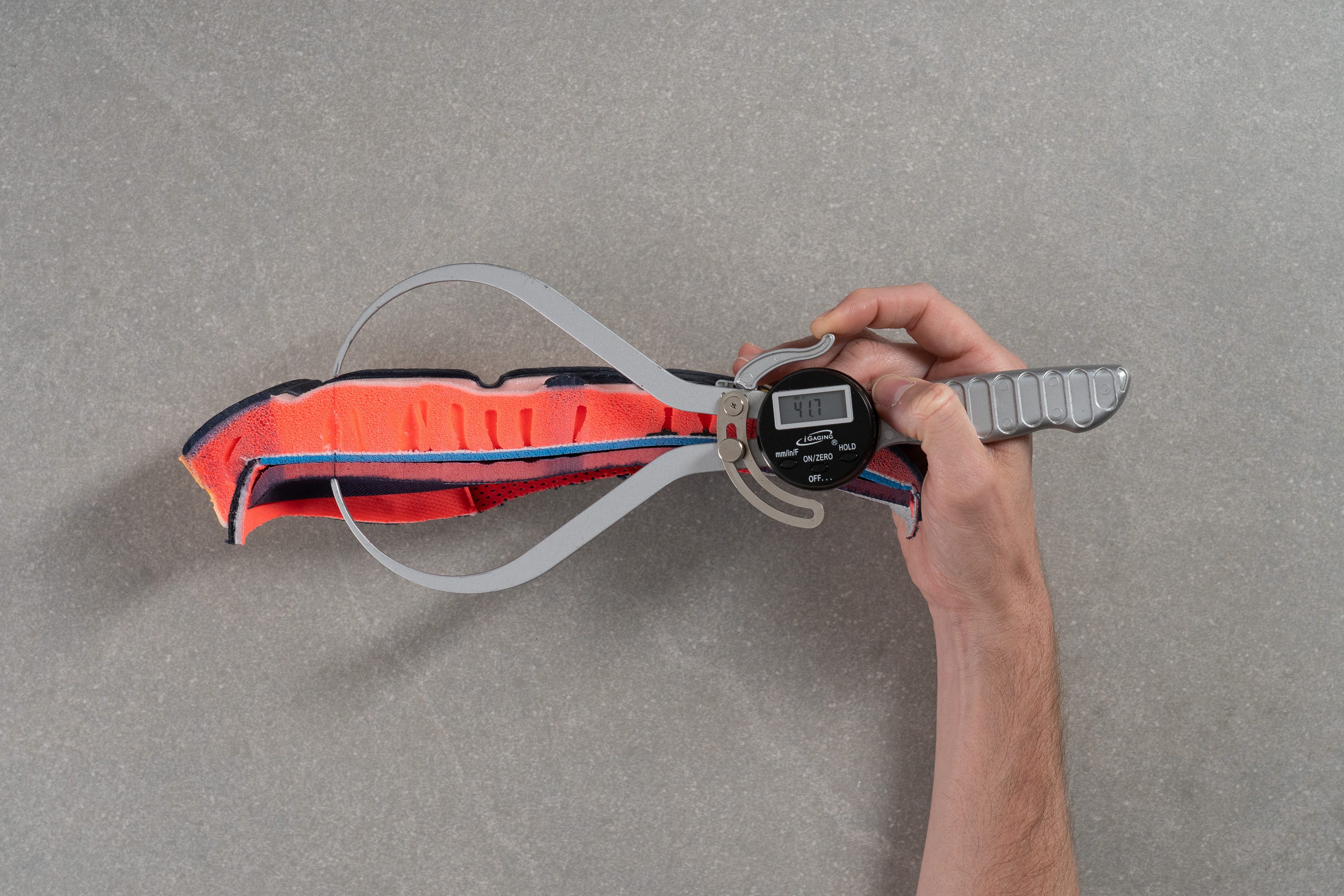
| Aero Burst | 41.7 mm |
| Media | 34.8 mm |
Altura de la suela en el antepié
Cuando medimos la altura de la suela en el antepié, nuestro calibre marcó 32,9 mm, lo que hace que sea altísima en comparación con la media.
Este diseño tan grandote hace que no sientas prácticamente nada el suelo bajo los pies, así que les ofrece una experiencia ideal a los corredores que priorizan la protección de sus músculos y articulaciones, y que pasan de una pisada más tradicional que esté más conectada con el suelo.
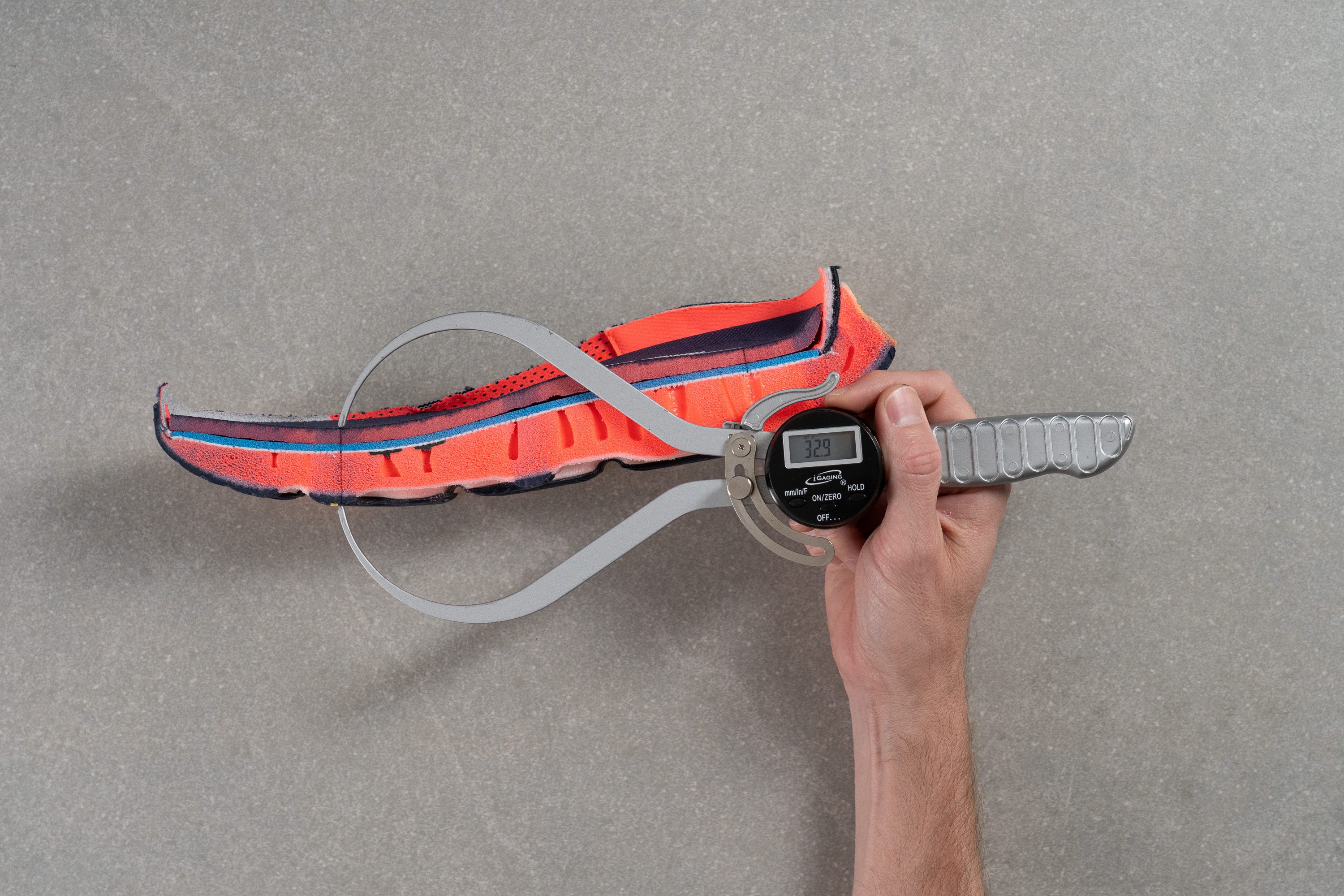
| Aero Burst | 32.9 mm |
| Media | 26.2 mm |
Drop
Cuando medimos el drop de estas zapatillas, nos dio 8,8 mm, que es más alto que los 6 mm que Skechers dice que tienen.
Sin embargo, cuando lo analizamos con lo altísima que es la suela y lo blanda que es la mediasuela Hyperburst ICE, descubrimos que los talonadores muy probablemente sientan que el drop es más bajo, ya que el pie se hunde en la espuma mullida, lo que hace que tengan la sensación de que la plataforma es más plana.
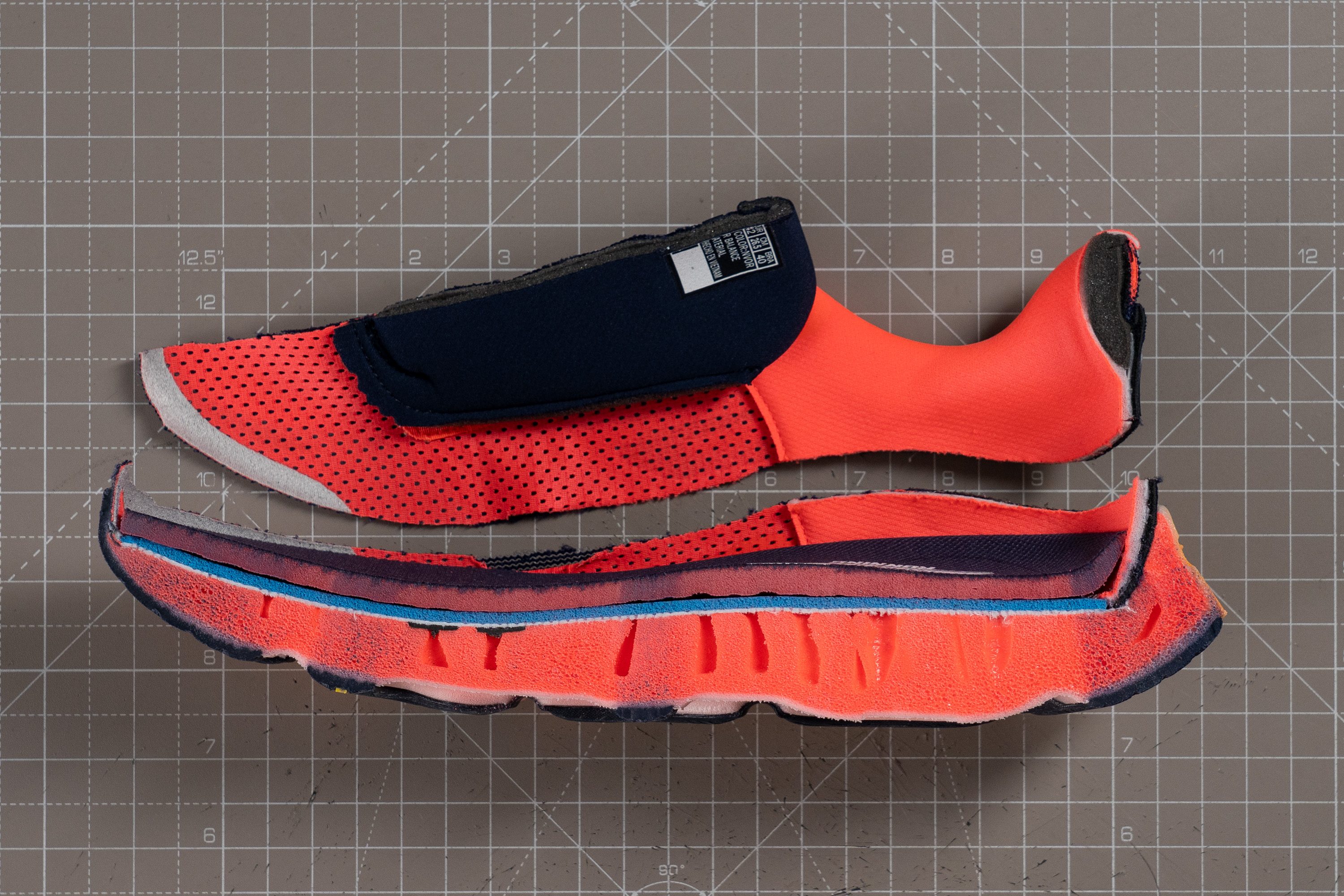
| Aero Burst | 8.8 mm |
| Media | 8.6 mm |
Suavidad de la mediasuela
No todas las zapatillas de running maximalistas son blanditas, y aunque una mediasuela grandota suele significar que la pisada va a ser mullida, ¡no tiene que ser siempre así!
Cuando analizamos la espuma de las Aero Burst, nuestro durómetro marcó solo 14,4 HA, así que es mucho más blandita que la media de las zapatillas de running. Esto lo sentimos directamente en nuestros pies, lo que hace que este modelo sea especialmente agradable para salir a trotar un rato o correr un poquito el finde.
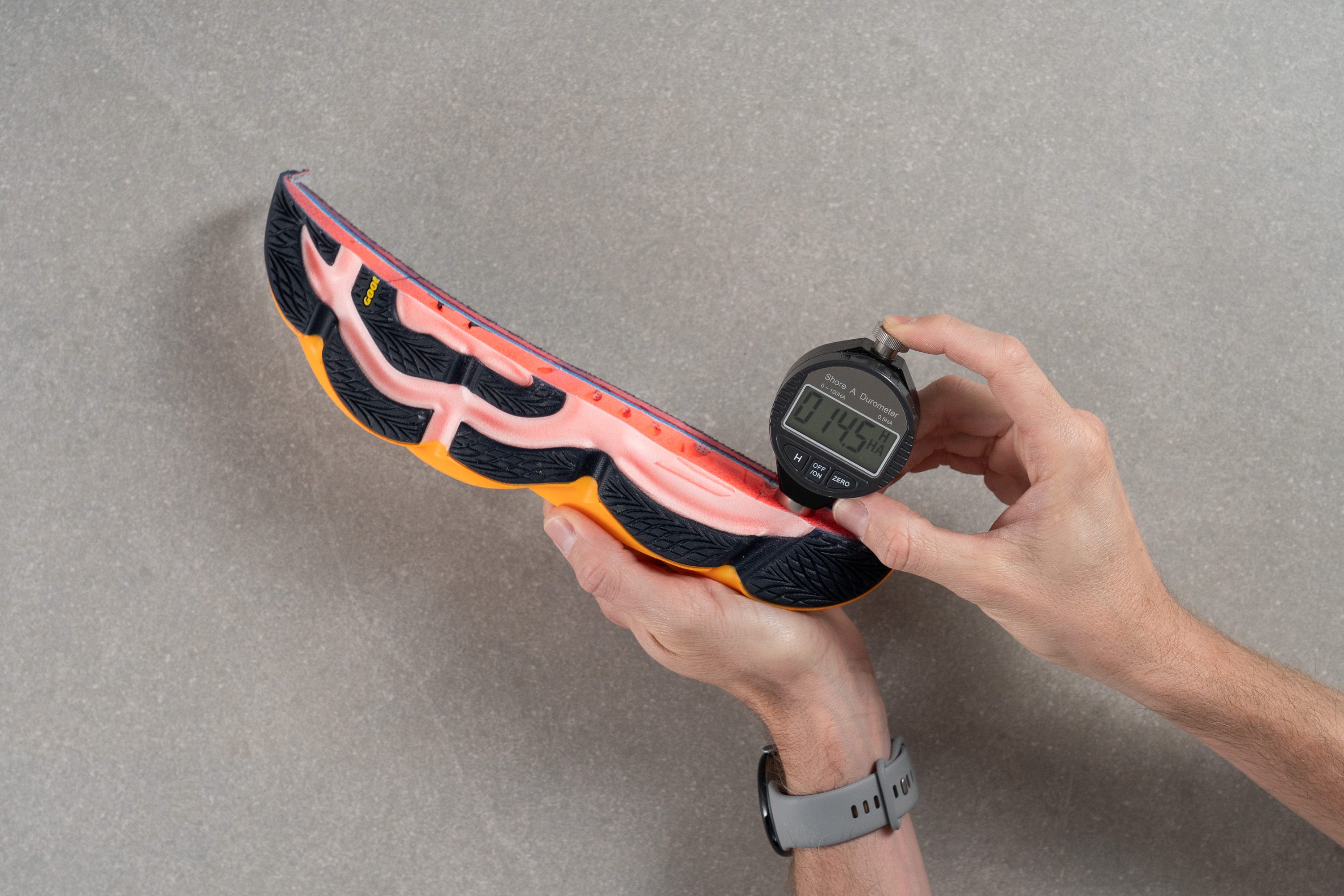
| Aero Burst | 14.4 HA |
| Media | 20.4 HA |
Rocker
Gracias al pronunciado rocker que tienen, cuando aterrizas con el talón o el mediopié, estas zapatillas impulsan tu pie hacia adelante de forma suave y rápida, con muy poco esfuerzo. Esto hace que correr sea más fácil y te ayuda a conservar energía, reduciendo la tensión en los tobillos y las pantorrillas.
Pero... sabemos que esto no les va a gustar a todos los corredores. Aunque las zapatillas maximalistas suelen beneficiarse de los rockers marcados, el diseño de estas lo lleva al extremo, y la sensación al correr puede resultar antinatural o demasiado asistida.
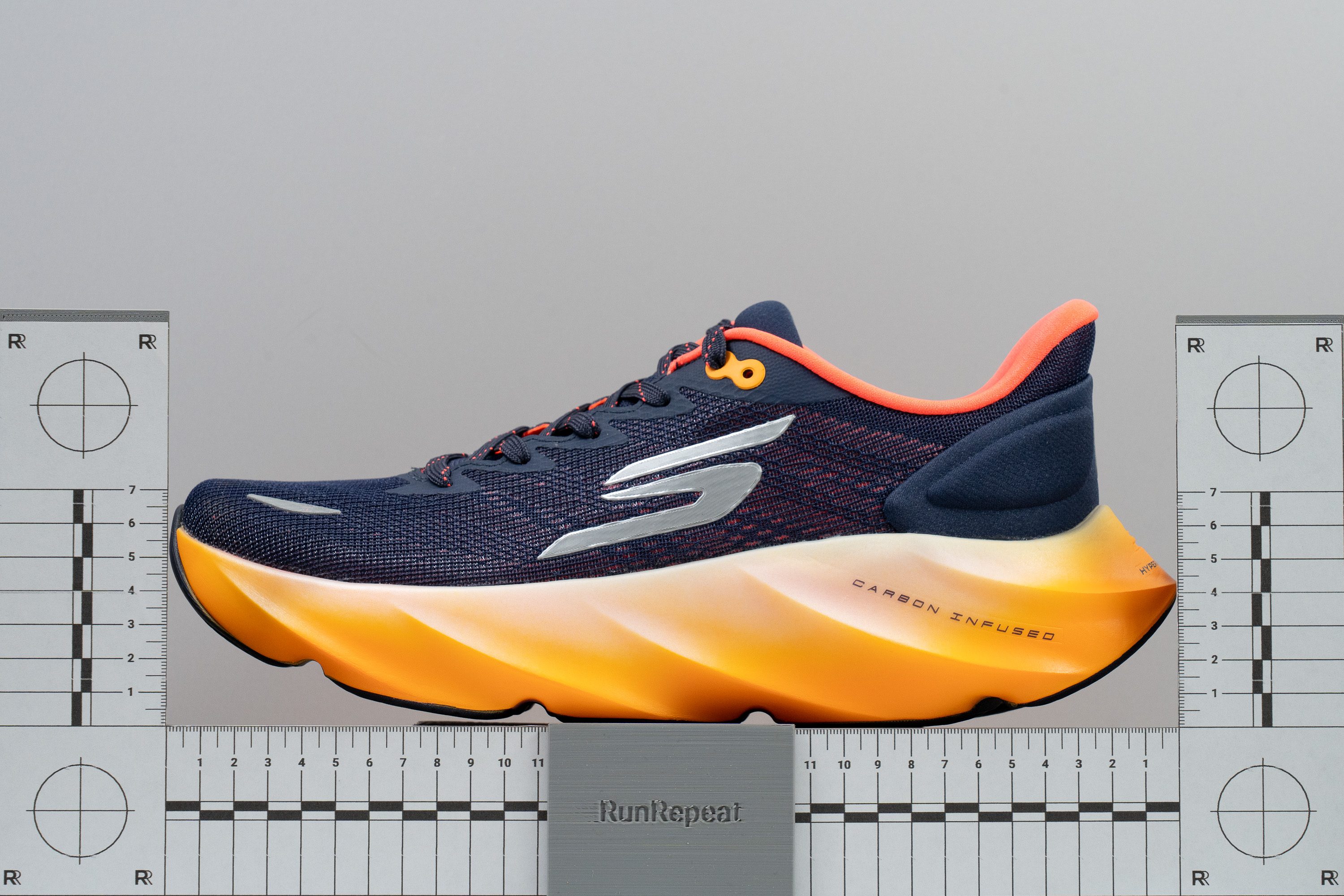
Tallaje y ajuste
Talla
Las Skechers Aero Burst tallan bien (75 votos).
Anchura / Ajuste
Como nos ponemos todos y cada uno de los pares que compramos en nuestras pruebas de uso, podemos decirte que este no tiene un ajuste espacioso.
Cuando analizamos estas Skechers en el laboratorio, vimos que su antepié tiene una anchura de 94,4 mm, que es un resultado inferior a la media.
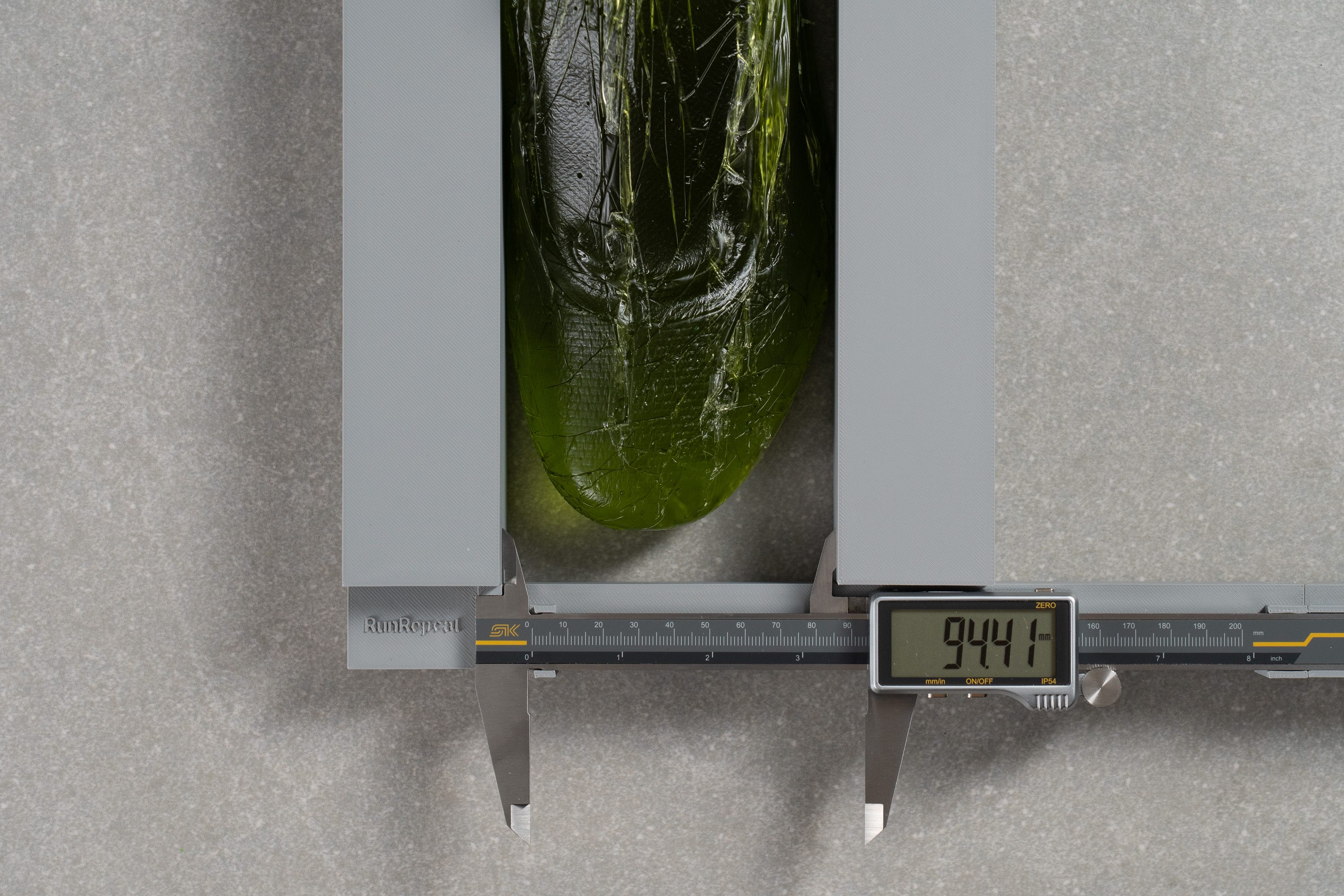
| Aero Burst | 94.4 mm |
| Media | 95.1 mm |
Anchura de la parte delantera
Cuando volvimos a medir la parte delantera, entendimos mejor las Aero Burst.
Y es que nuestro calibre marcó solo 70,7 mm. Aunque no nos parecieron ni demasiado apretadas ni demasiado incómodas cuando nos las pusimos, creemos que su estructura estrecha no es ideal para las personas con pies anchos.
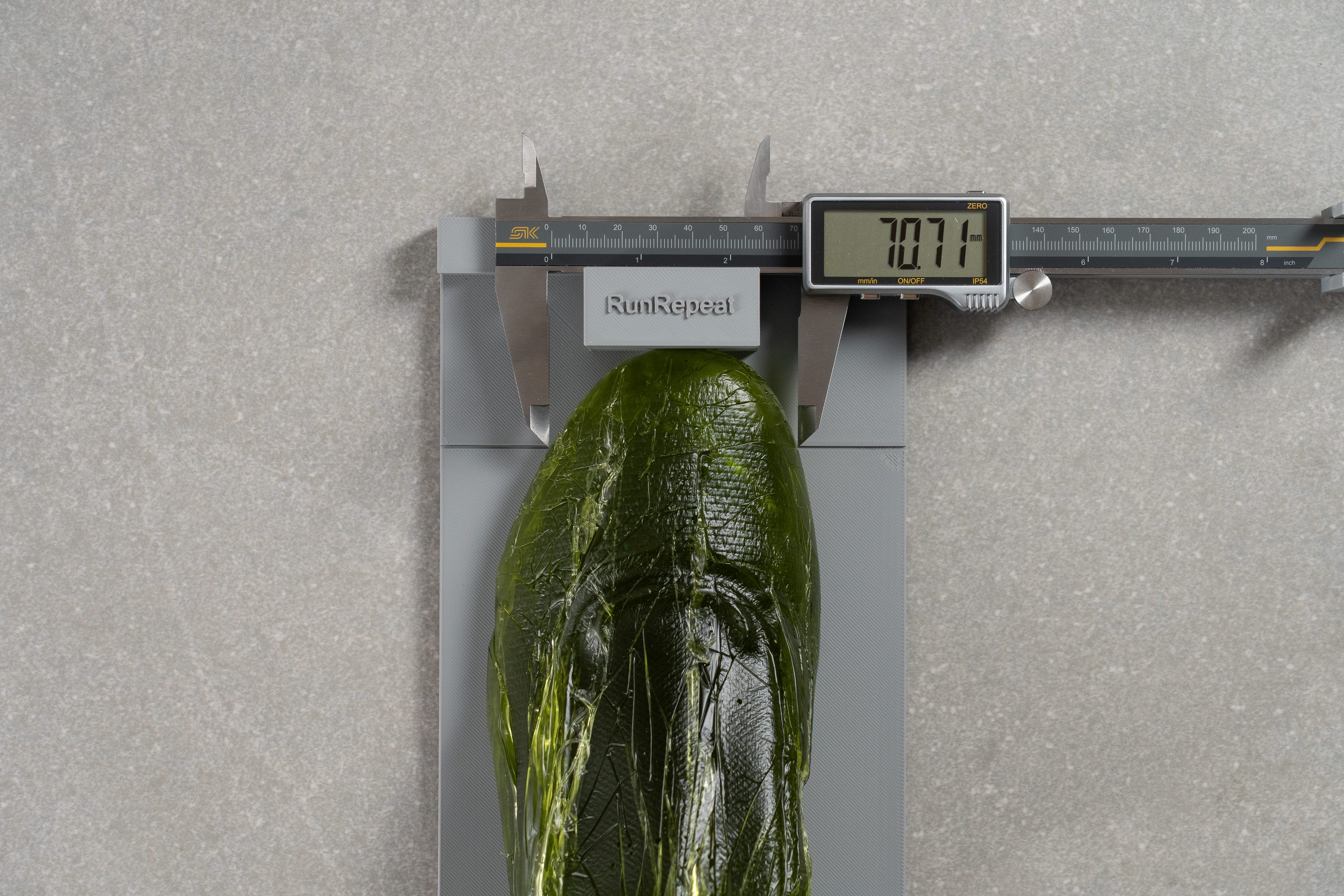
| Aero Burst | 70.7 mm |
| Media | 73.2 mm |
Altura de la parte delantera
Pero espera, que todavía tenemos más que decir sobre la parte delantera..., ¡y es que nos falta hablar de su altura!
Resulta que son muy bajitas, con solo 23,0 mm, así que el ajuste es ceñido y se centra en mantener el control. Claramente, esto favorece a los corredores con pies de bajo volumen.
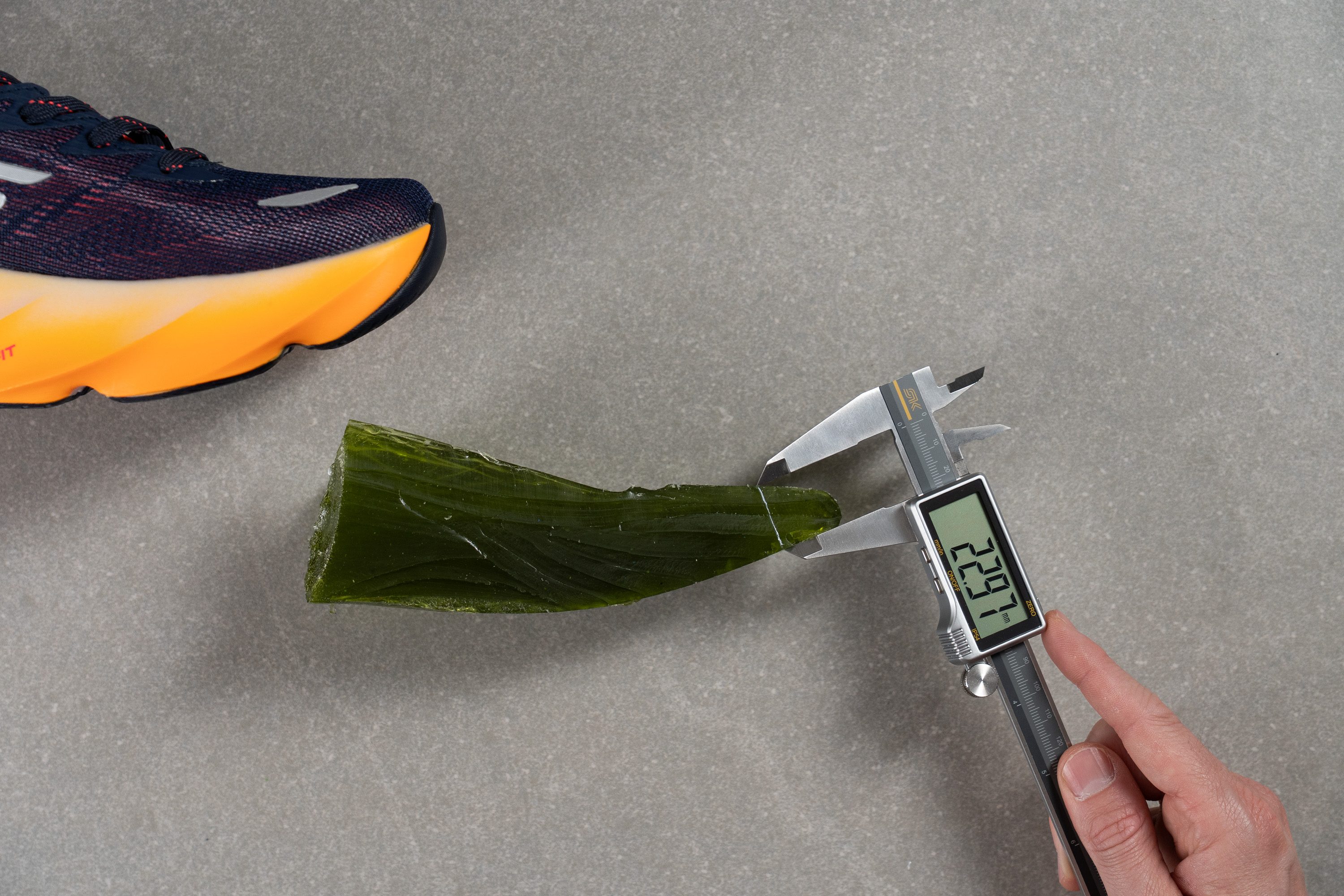
| Aero Burst | 23.0 mm |
| Media | 27.1 mm |
Tracción / Agarre
Traction test
Desde que Adidas se asoció con Continental y recibió tantos elogios, muchas marcas de running comenzaron a contactar a empresas de neumáticos para hacer lo mismo. De todas ellas, Skechers decidió llamar a GoodYear.
Aunque el resultado no alcanza el nivel de las suelas Conti más impresionantes, las Aero Burst tienen un caucho de alta calidad, ¡y eso es innegable! Cuando lo analizamos en nuestra prueba de tracción, obtuvo un sólido 0,48, lo que confirma que ofrece un agarre fiable tanto si el asfalto o el hormigón están secos como mojados.
| Aero Burst | 0.48 |
| Media | 0.48 |
Diseño de la suela exterior
La suela exterior está totalmente cubierta de caucho, con una zona protegida en la parte central del antepié. Este diseño protege totalmente las zonas de mayor desgaste y no añade mucho peso.
Otro detalle importante es el dibujo de la suela, que imita el relieve de los neumáticos Goodyear. Este diseño mejora la tracción en asfalto liso, aceras y baldosas. Por otro lado, en los caminos de tierra, el rendimiento es aceptable, aunque lo mejor es evitar las rutas que tienen muchos obstáculos o con piedrecillas, ya que hay demasiada espuma expuesta.
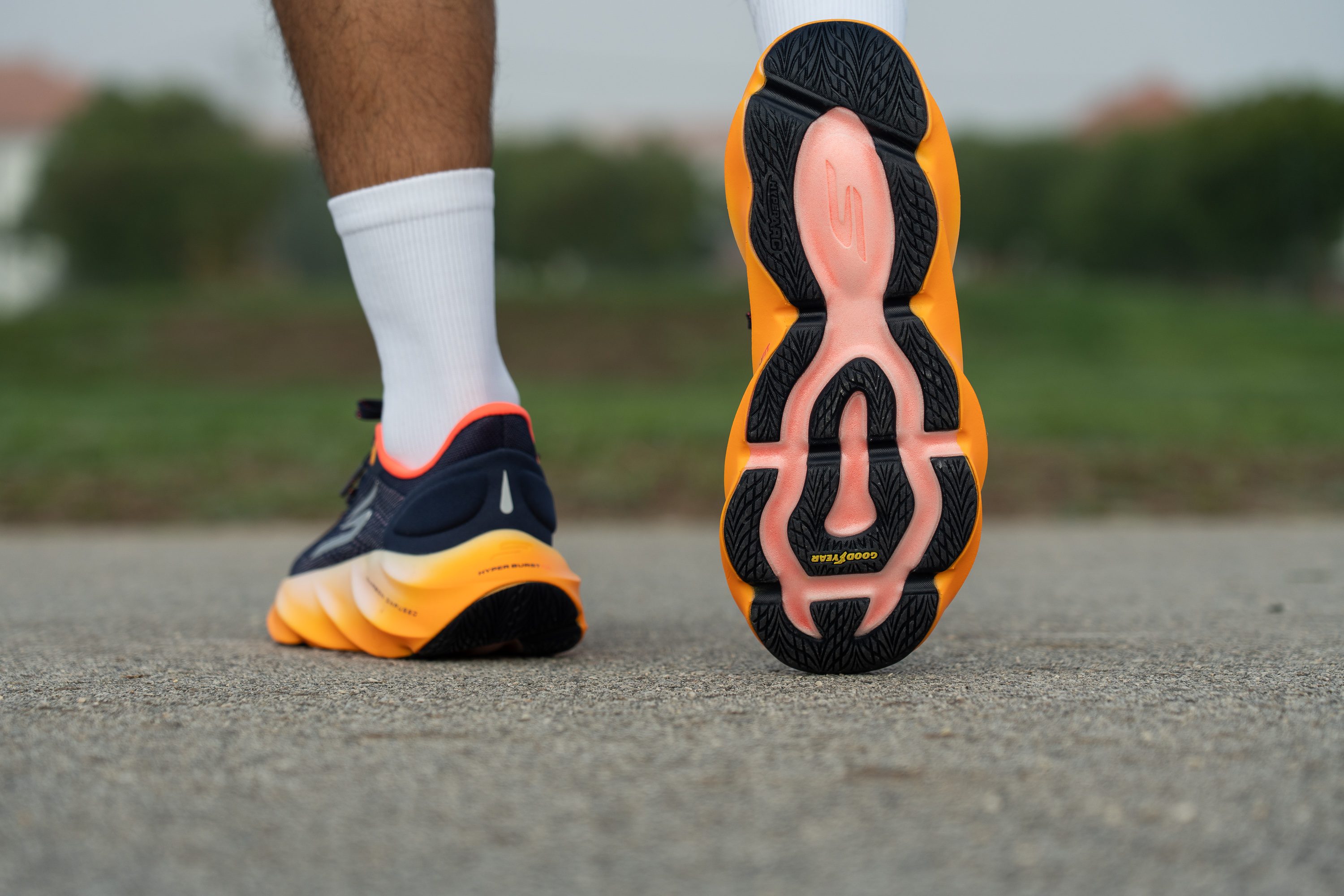
Flexibilidad / Rigidez
Estas zapatillas no son flexibles, pero teniendo en cuenta lo alta que es su suela, los 15,3 N que necesitaron para doblarse 30 grados nos parecen más que razonables.
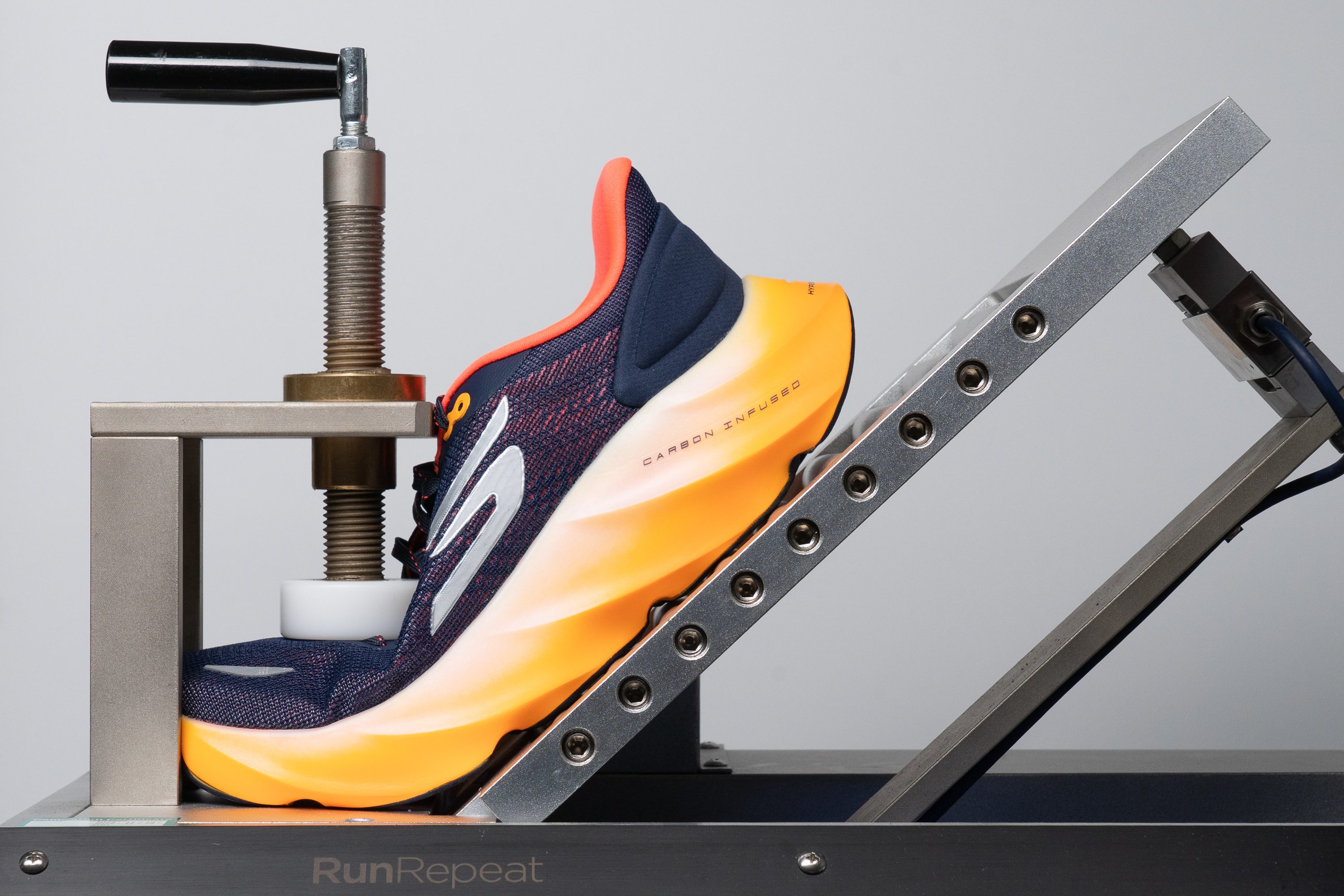
| Aero Burst | 15.3N |
| Media | 15.3N |
Peso
Este podría ser el punto de inflexión principal para muchos runners, ¡así que ojo! Las Aero Burst pesan 322 g, que es más de lo que nos gustaría... incluso teniendo en cuenta que tienen una suela altísima.
Si el peso te da bastante igual y estás buscando unas zapatillas solo para trotar de tranquis y para las tiradas fáciles, entonces no hay problema. Pero claro, hay un montón de modelos que tienen suelas incluso más altas pero que pesan hasta un 20 % o 30 % menos. Siendo sinceros, creemos que estamos ante una desventaja importante que Skechers debería solucionar en la versión 2.
| Aero Burst | 11.4 oz (322g) |
| Media | 9.3 oz (264g) |
Transpirabilidad
La transpirabilidad de las Aero Burst no está nada mal, pero tampoco es que podamos decir que destacaron en nuestra prueba de humo. Vamos, que se llevaron un 3/5.
Eso sí, antes de nada, queremos decir que no estamos ante un diseño común que hasta nos ha supuesto un reto a la hora de analizarlo. ¿Que por qué? Pues mira, la mayoría de las zapatillas se centran en que la parte delantera se encargue del flujo de aire y de que el mediopié tenga refuerzos, pero Skechers va por otro camino. Les puso a estas zapatillas paneles bien ventilados en los laterales, que es algo poco común en un modelo de entrenamiento diario.
Otra cosa que nos llamó la atención es que el humo parecía quedarse más atrapado de lo que la foto de nuestro microscopio sugería, ya que la malla parece muy transpirable.
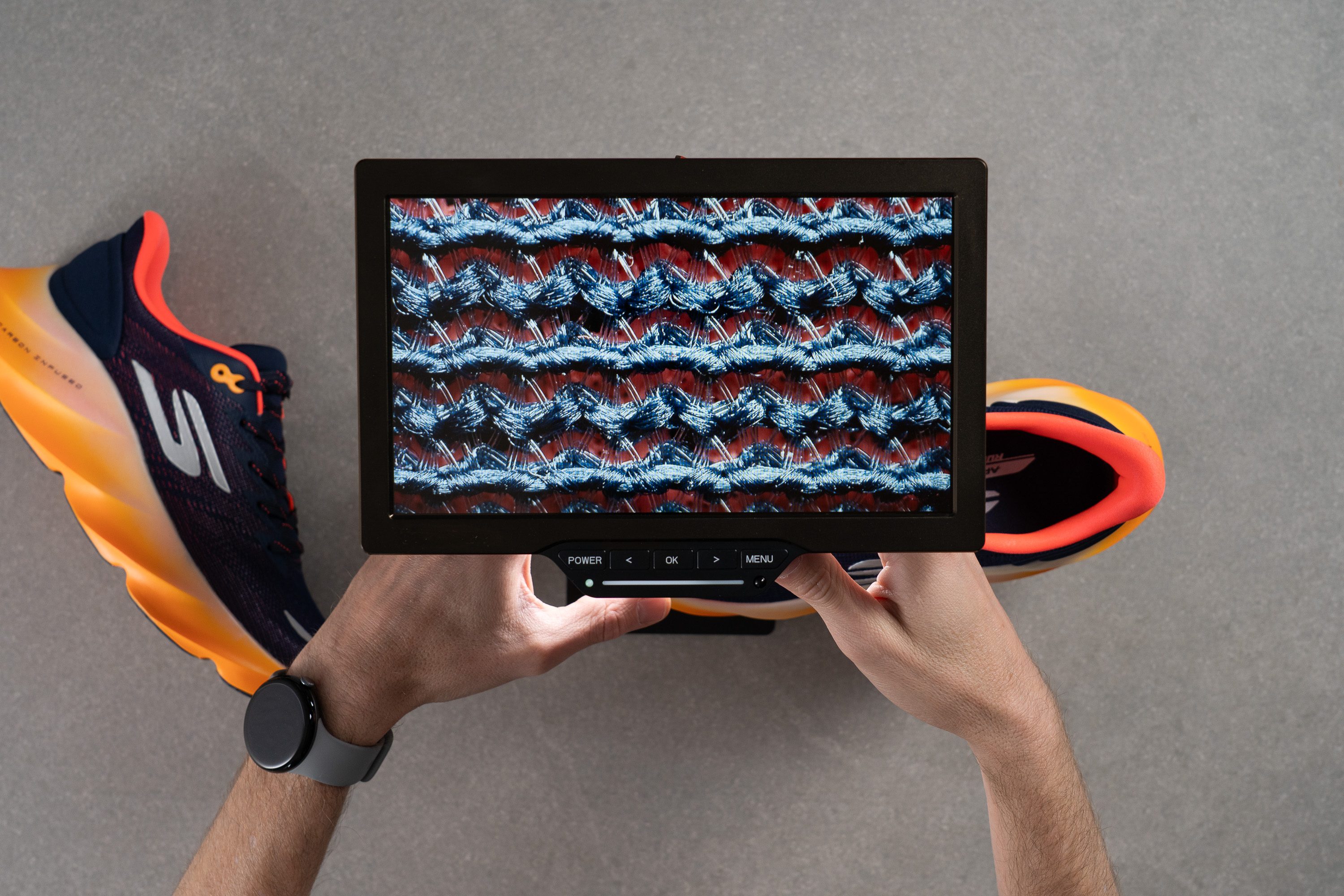
En nuestra opinión, este upper está diseñado prestándole mucha atención a cada detalle: es finito y abierto por delante, pero tanto la lengüeta como el talón están muy acolchados.
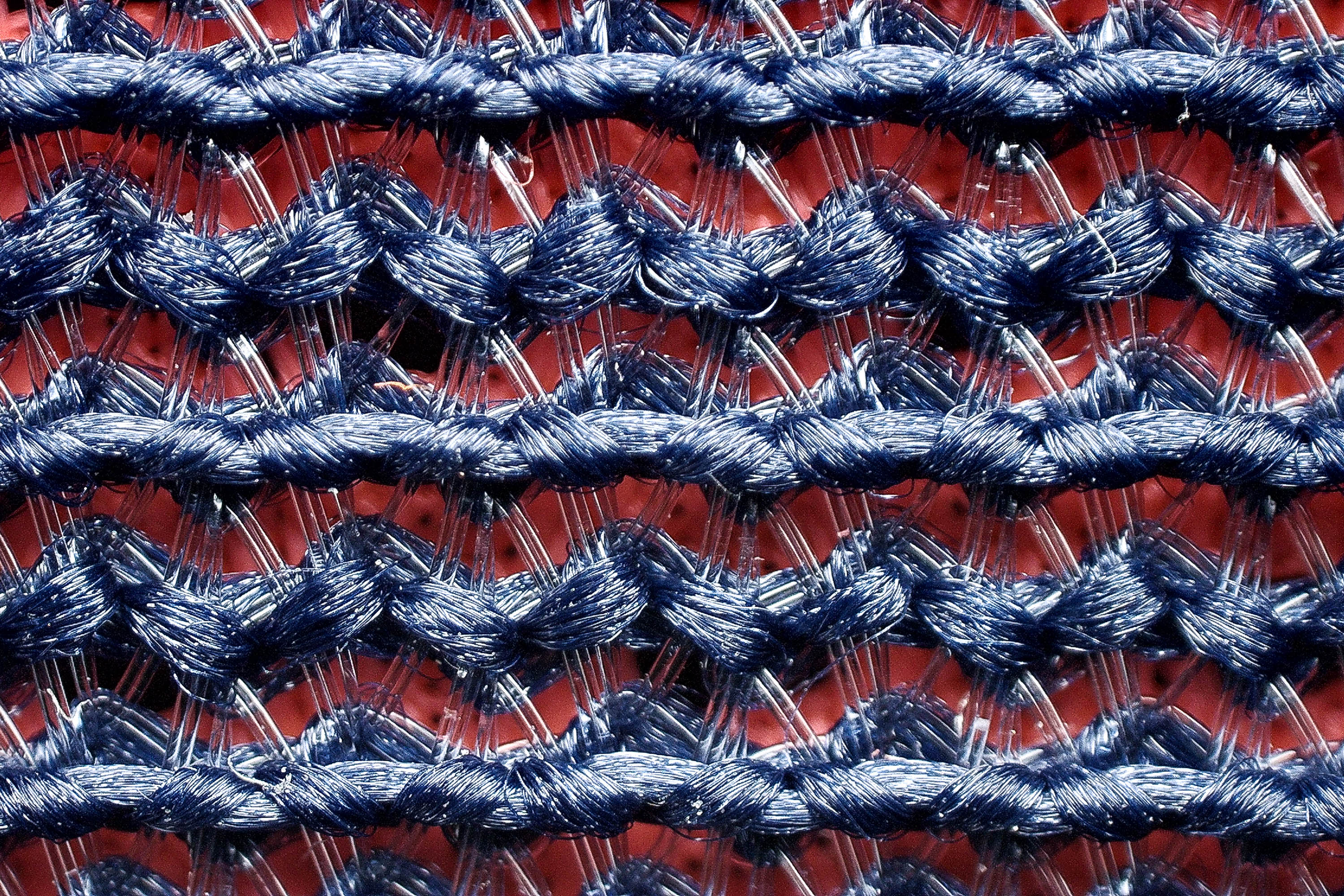
Esta combinación hace que las zapatillas sean cómodas desde el minuto 1, y cuanto más te las pones, ¡más premium se sienten! Vamos, que sientes que son seguras y cómodas incluso en las tiradas largas.
| Aero Burst | 3 |
| Media | 3.7 |
Estabilidad
Prueba de estabilidad lateral
Las Aero Burst tienen una placa de carbono en forma de H en la mediasuela que les proporciona estabilidad; y teniendo en cuenta lo altas que son, ¡sin duda es algo muy necesario! La sensación es parecida a la del sistema H-Frame utilizado en modelos como las HOKA Arahi 8, y a diferencia de las placas diseñadas pensando en el rendimiento que tienen las superzapatillas, esta funciona principalmente como un elemento estructural.
También hay un refuerzo muy grande en el talón que controla las fuerzas laterales para los talonadores. Es algo que nos parece clave en estas zapatillas, ya que la mediasuela no es tan ancha como la de muchas de sus competidoras.
Rigidez torsional
Que unas zapatillas tengan la placa en forma de H para mejorar la estabilidad tiene un efecto secundario: que la rigidez torsional sea altísima. Este modelo se llevó un 5/5 en nuestra prueba, lo que hace que sea más estable, pero no a todos los corredores les va a gustar esa sensación de rigidez.
| Aero Burst | 5 |
| Media | 3.5 |
Rigidez del contrafuerte del talón
A Skechers le encanta ponerles nombres a sus características, y el contrafuerte del talón ha sido bautizado como la “Heel Pillow” (básicamente, la almohada del talón). Se llevó un 4/5 en nuestra prueba de rigidez, pero como está tan acolchado, sigue siendo muy cómodo.
| Aero Burst | 4 |
| Media | 2.9 |
Anchura de la mediasuela - antepié
La mayoría de las zapatillas maximalistas no solo son más altas, sino también más anchas. Pero Skechers decidió seguir otro camino con las Aero Burst, y la verdad es que se lo agradecemos, ya que son como un soplo de aire fresco..., ¡porque todas las marcas repiten la misma fórmula!
Con 117,0 mm, el antepié es un poquito más ancho que la media, pero cuando lo combinamos con lo alta que es la mediasuela... la verdad es que se siente relativamente estrecho. Incluso así, esa forma tan única que tiene la mediasuela y la rígida placa con forma de H ayudan a compensar esta estructura menos ancha.
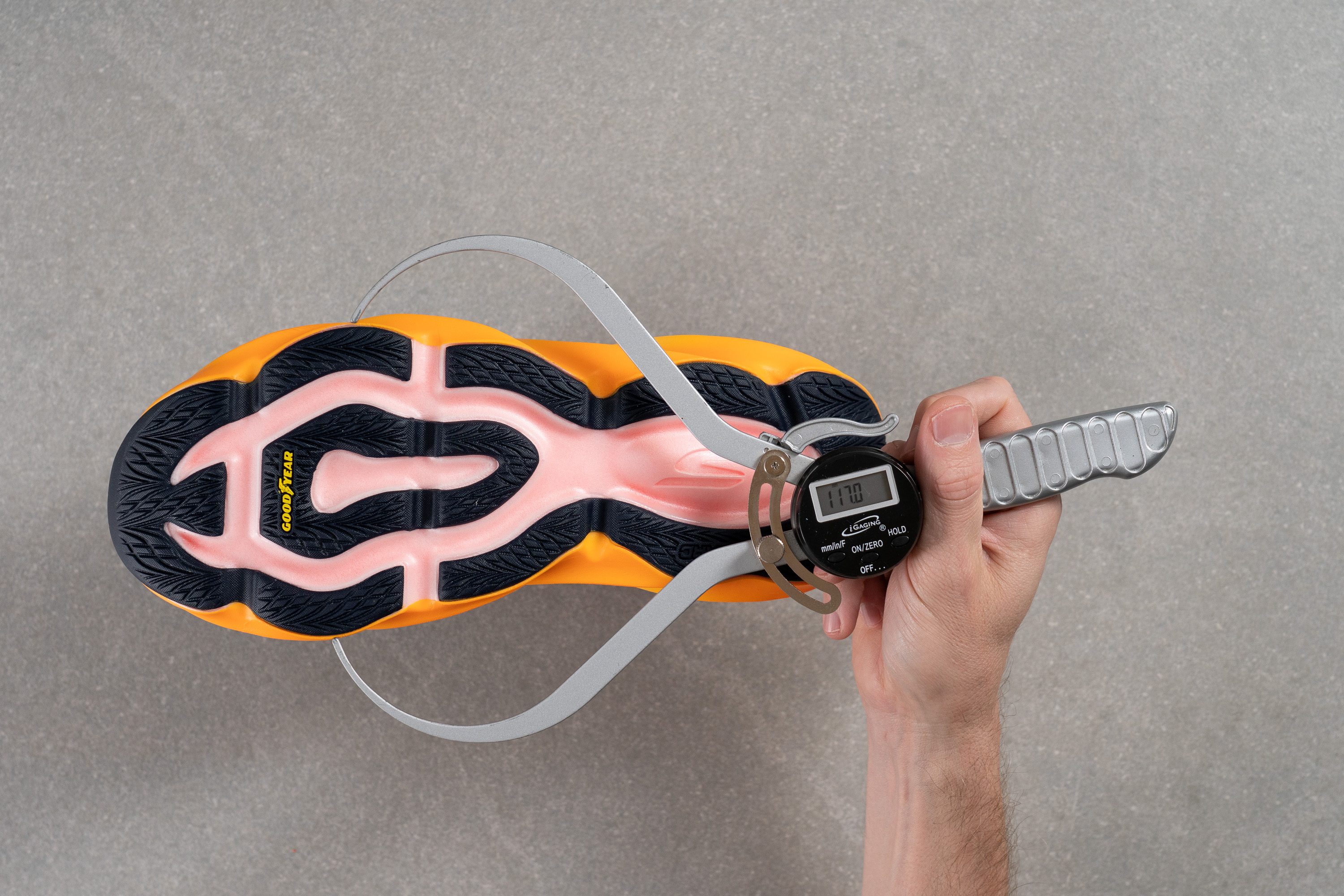
| Aero Burst | 117.0 mm |
| Media | 114.4 mm |
Anchura de la mediasuela - talón
Esto que acabamos de decir se vuelve incluso más evidente en el talón, que mide solo 85,6 mm. Pero fíjate bien en la foto: esas protuberancias de la mediasuela ayudan a estabilizar el talón, a la vez que hacen que el punto de contacto con el suelo sea más estrecho.
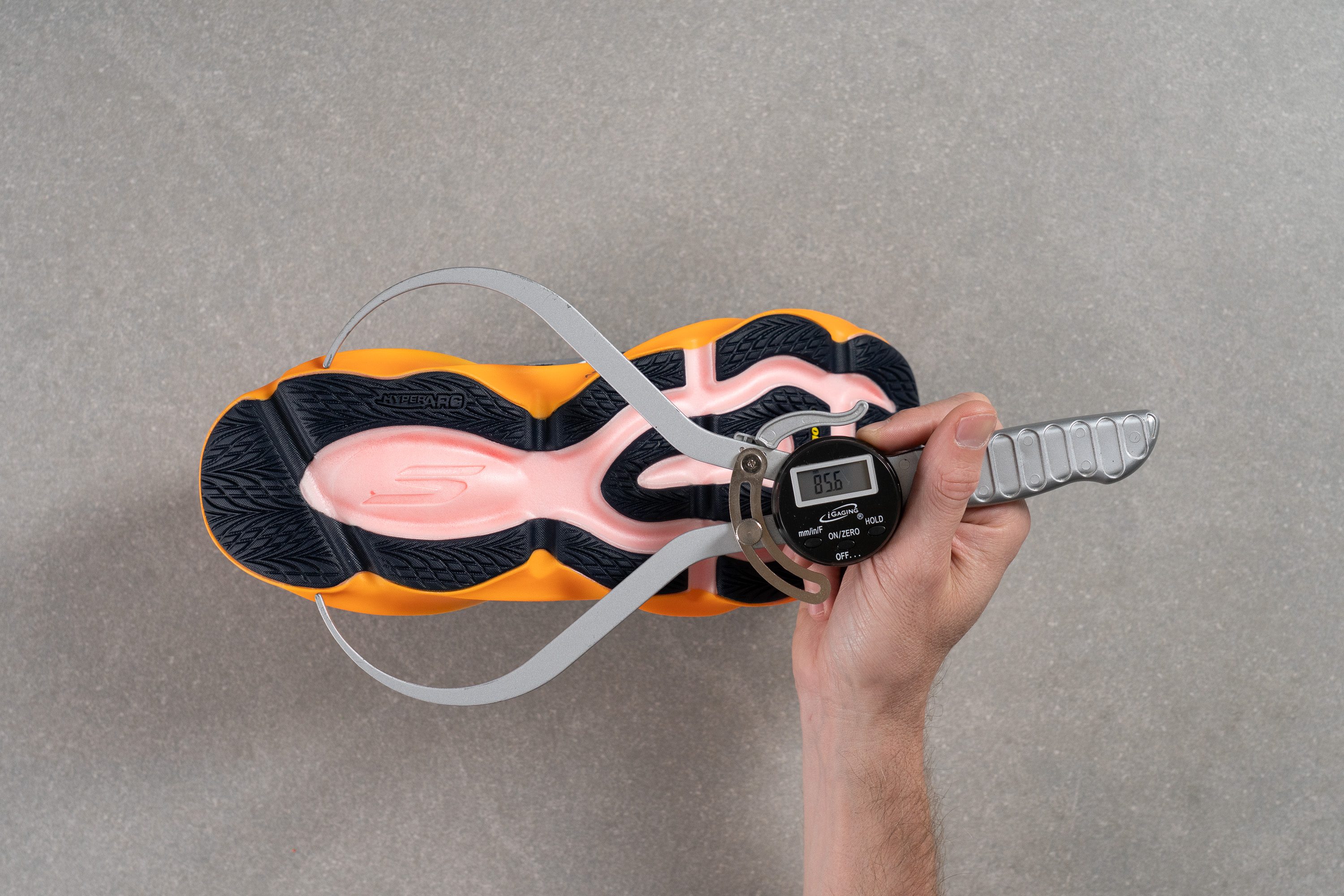
| Aero Burst | 85.6 mm |
| Media | 90.7 mm |
Durabilidad
Durabilidad de la parte delantera
El upper tiene tantas aberturas que hasta nos daba miedo que su durabilidad fuese baja. Sin embargo, lo hizo bastante bien en nuestra prueba de durabilidad, llevándose un respetable 3/5.
| Aero Burst | 3 |
| Media | 2.6 |
Durabilidad del acolchado del talón
El llamado "Heel Pillow" también nos dejó claro que su rendimiento es impresionante, y es que se llevó un 4/5 en nuestra prueba. Este resultado está muy por encima de la media, así que no hay nada de lo que preocuparse en este aspecto.
| Aero Burst | 4 |
| Media | 3.4 |
Durabilidad de la suela
La colaboración con GoodYear no solo mejoró la tracción de la suela, ¡sino también su durabilidad!
Cuando la analizamos con nuestro Dremel, vimos que los daños eran de solo 0,8 mm, lo que demuestra que esta suela exterior es ideal para los runners que les dan mucha caña a sus zapatillas y que, a su vez, también necesitan que tengan un agarre fiable.
| Aero Burst | 0.8 mm |
| Media | 1.1 mm |
Grosor de la suela
Skechers también se aseguró de ponerles una capa de caucho sólida a estas zapatillas, con un grosor de 3,9 mm. A lo mejor es incluso demasiado si tenemos en cuenta que estas Skechers ya son pesadas.
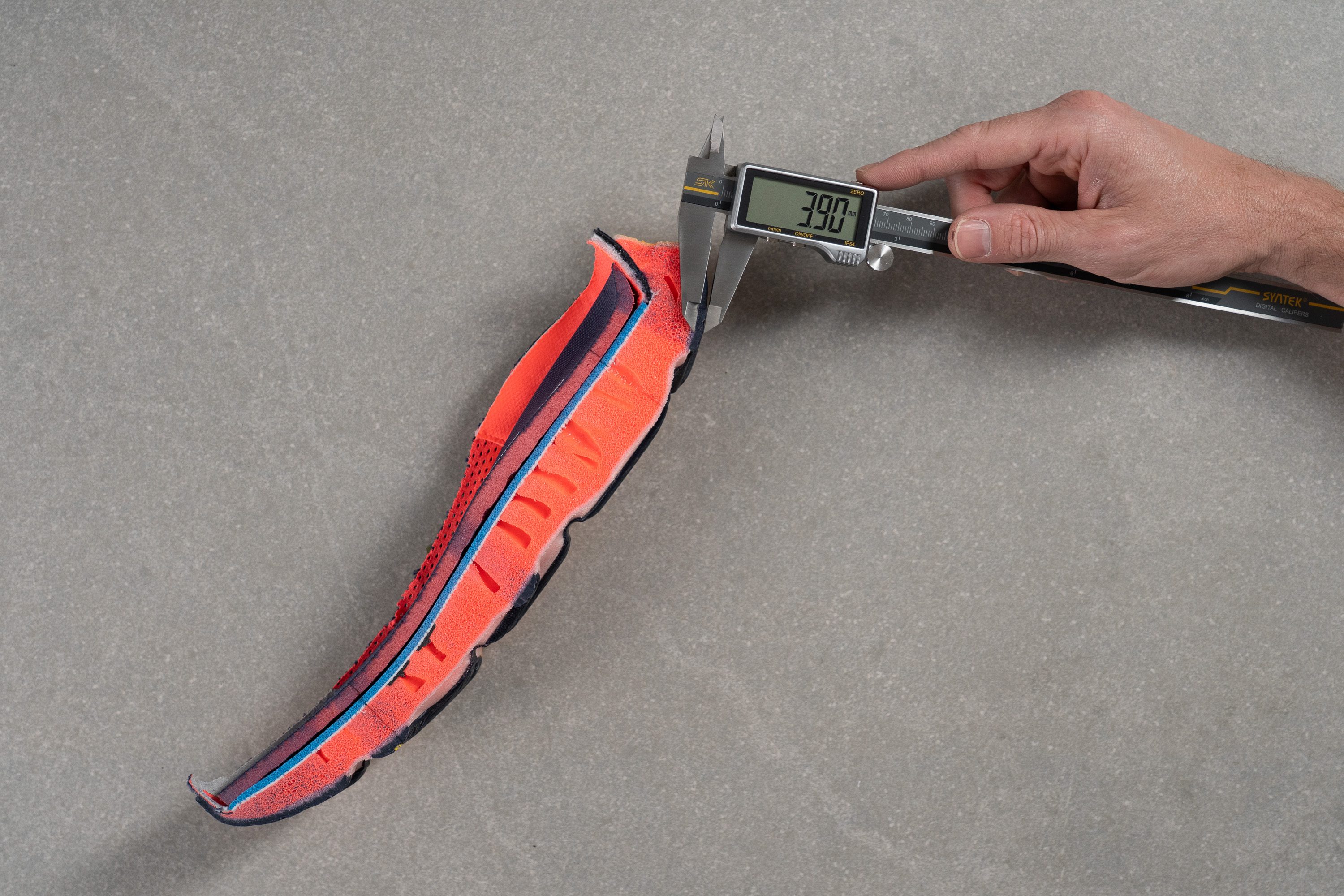
| Aero Burst | 3.9 mm |
| Media | 3.2 mm |
Varios
Grosor de la plantilla
La plantilla de las Aero Burst proporciona un extra de amortiguación muy por encima de lo habitual. Su diseño es parecido al de algunos modelos de Saucony, con un generoso grosor de 6,2 mm.
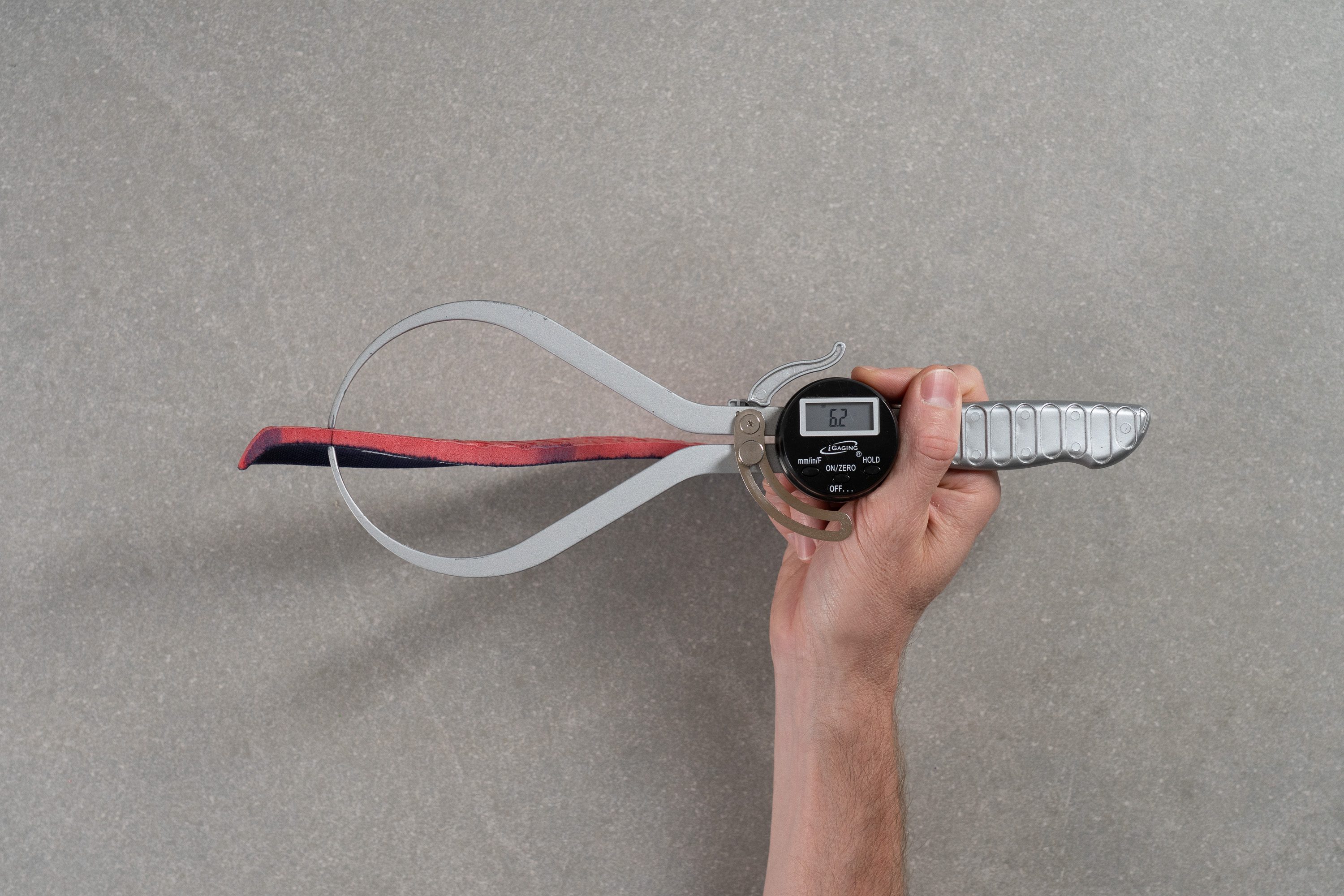
| Aero Burst | 6.2 mm |
| Media | 4.5 mm |
Plantilla extraíble
La plantilla ArchFit es menos intrusiva que la de las versiones anteriores, y eso nos encanta. Además, está hecha con el mismo material de espuma EVA supercrítica (a diferencia de la mayoría de sus competidoras, que usan EVA simple). Vamos, que nuestra recomendación es que no la cambies. Pero si necesitas hacerlo sí o sí, no te preocupes, porque es extraíble.
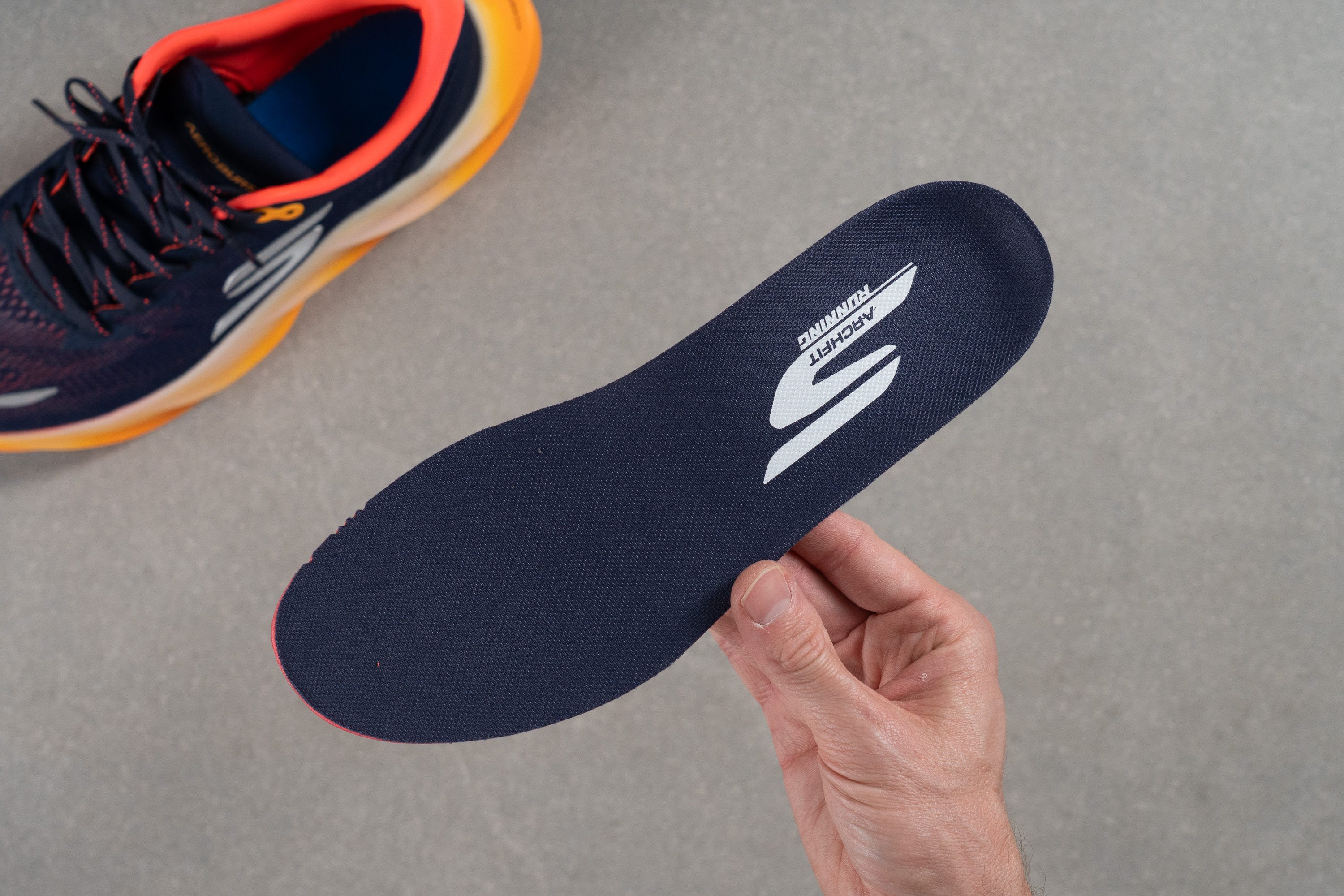
| Aero Burst | Sí |
Rigidez de la mediasuela en frío (%)
La espuma Hyperburst ICE tiene un buen rendimiento y, sinceramente, estamos satisfechos con ella; solo que..., ¡al final sigue siendo EVA! Esto significa que su rendimiento cuando hace frío no es el mejor, ya que se volvió un 29 % más rígida después de estar 20 minutos en el congelador de nuestro laboratorio.
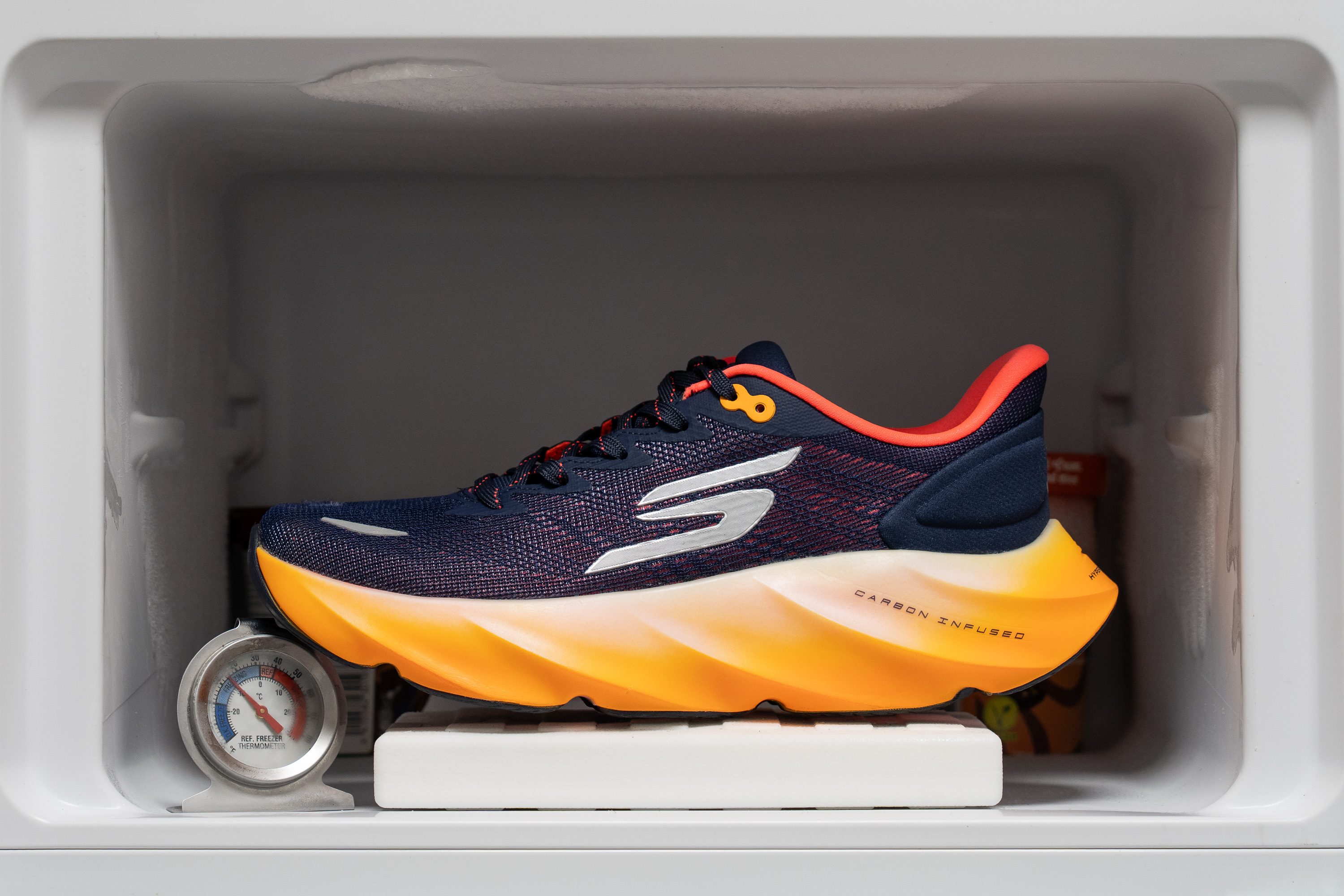
| Aero Burst | 29% |
| Media | 24% |
Elementos reflectantes
Las Skechers Aero Burst tienen algunos elementos reflectantes. No son los más increíbles que hemos visto en el laboratorio, pero ofrecen un poco más de visibilidad, ¡que siempre es mejor que nada!
| Aero Burst | Sí |
Acolchado de la lengüeta
Los ojales de la parte de arriba tienen refuerzos superpuestos que aumentan la durabilidad y evitan que se desgarren, incluso si te atas fuerte los cordones. Además, tienen relieve, así que es más difícil que se desaten.
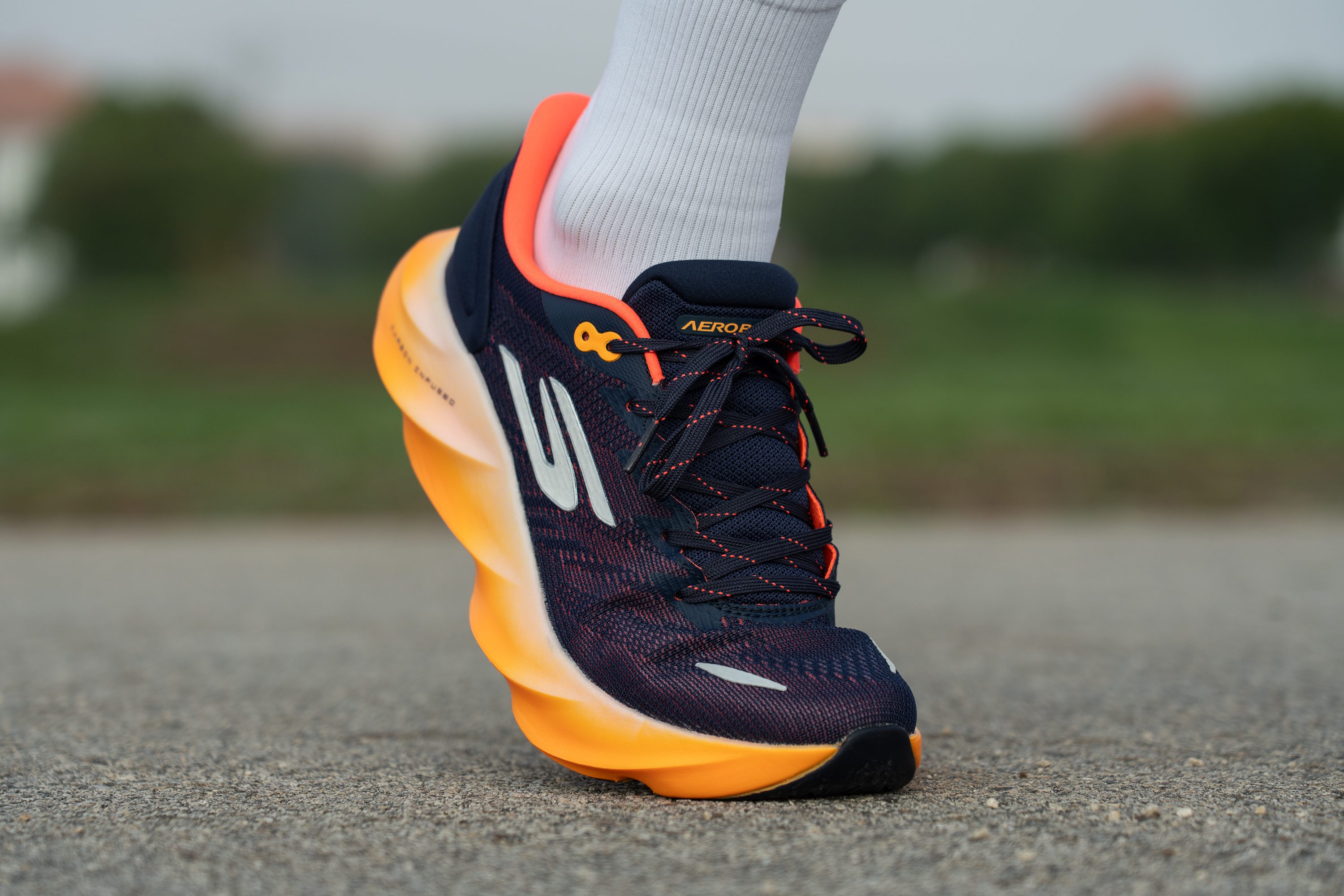
Uno de los elementos clave para que este modelo sea cómodo desde el minuto 1 es la lengüeta. Skechers lo tiene claro, así que se la jugó un poco con el peso al optar por un diseño de 8,0 mm de grosor, así que las zapatillas son cómodas incluso si te las pones durante todo el día.
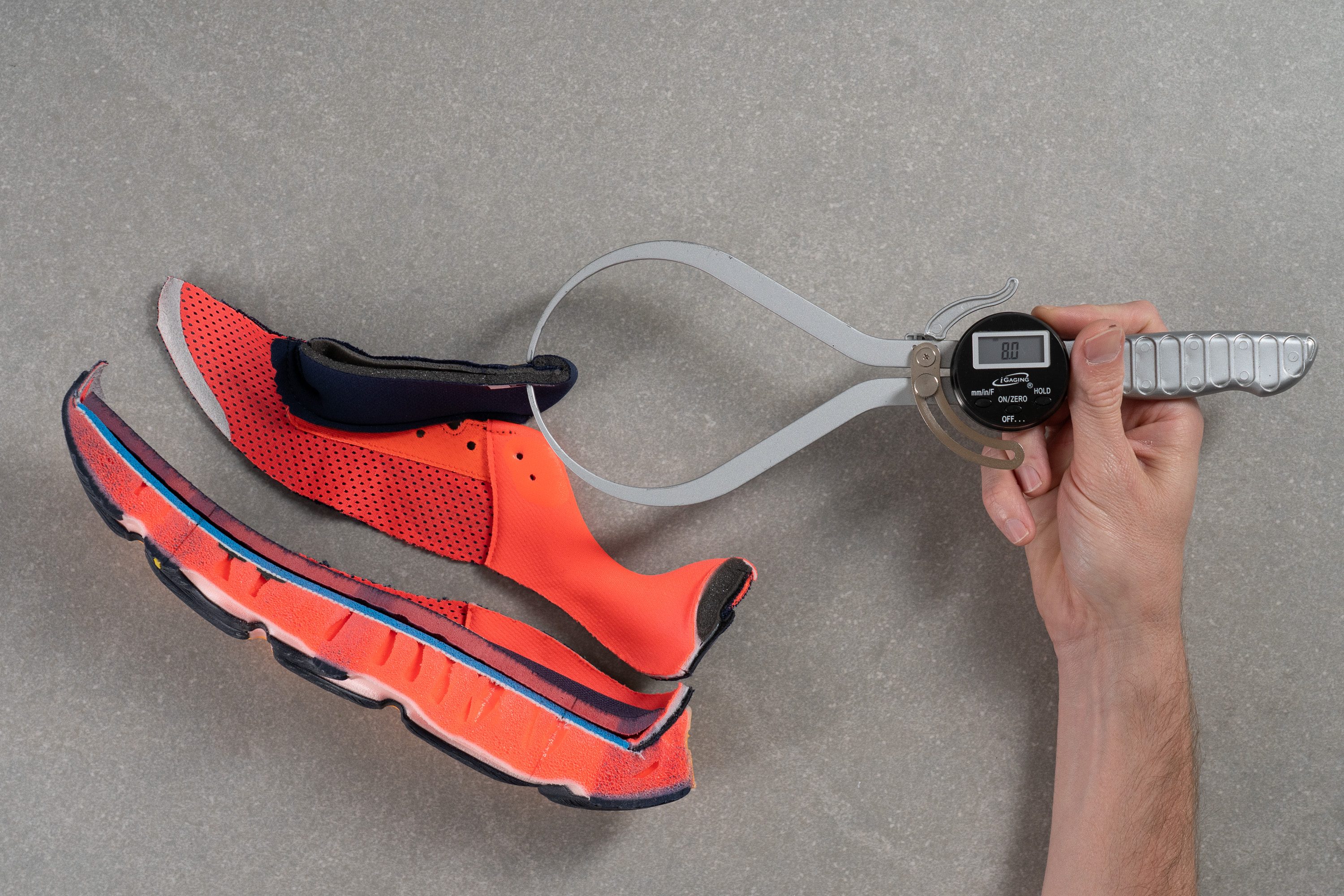
| Aero Burst | 8.0 mm |
| Media | 5.8 mm |
Lengüeta: tipo de refuerzo
La lengüeta de las Aero Burst es un poco diferente a la que solemos ver. Tiene refuerzo, pero solo por un lado.
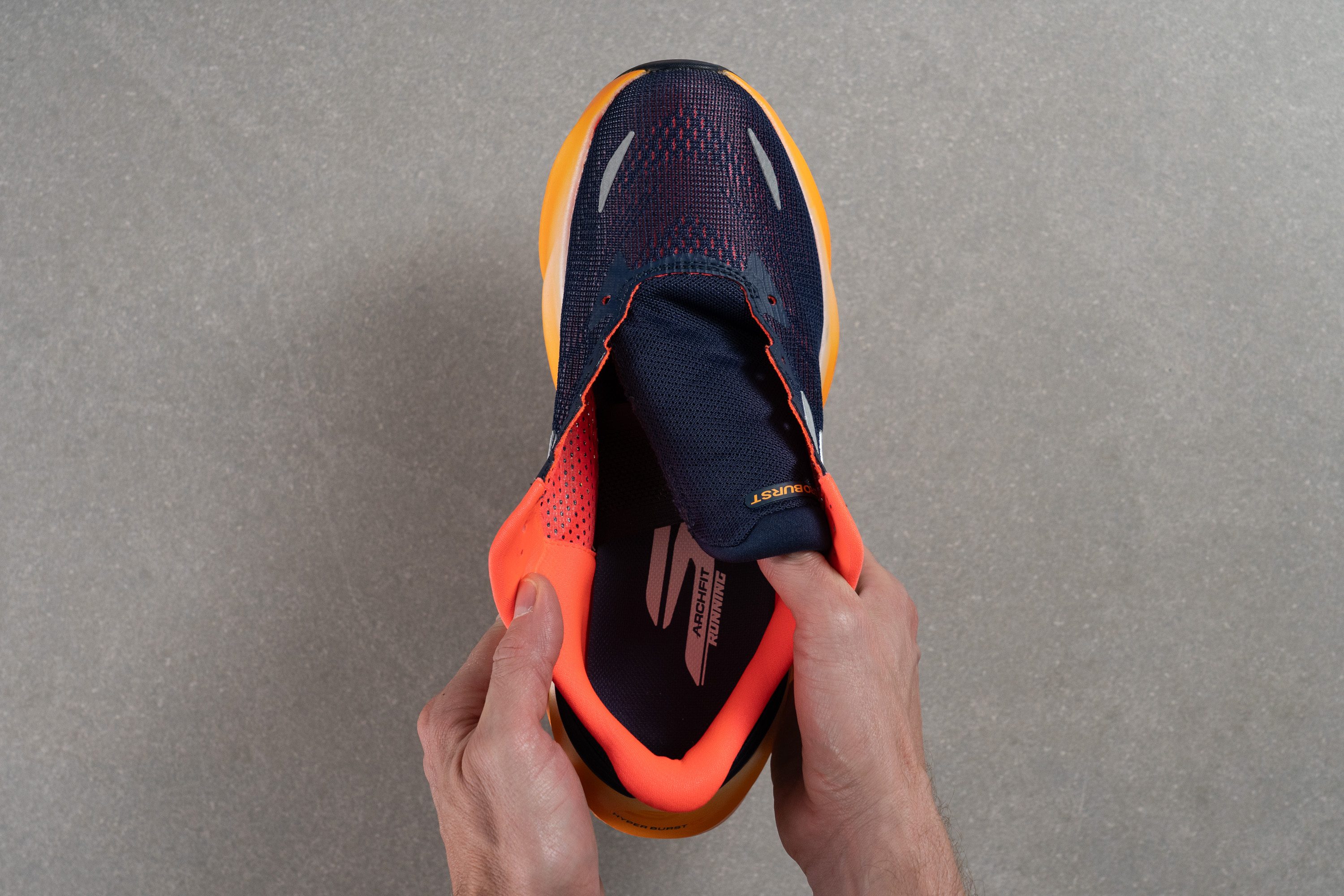
Precio
Teniendo en cuenta todos los resultados de nuestras pruebas de laboratorio, no podemos decir que las Skechers Aero Burst sean caras. El retorno de energía es sólido, son cómodas y tienen la suela GoodYear, ¡y eso que cuestan lo mismo o menos que muchas de sus competidoras!
| Aero Burst | $150 |
Tirador del talón
Este diseño del tirador en el talón está un poco acolchado y tiene una extensión, lo que hace que calzarse sea más fácil.
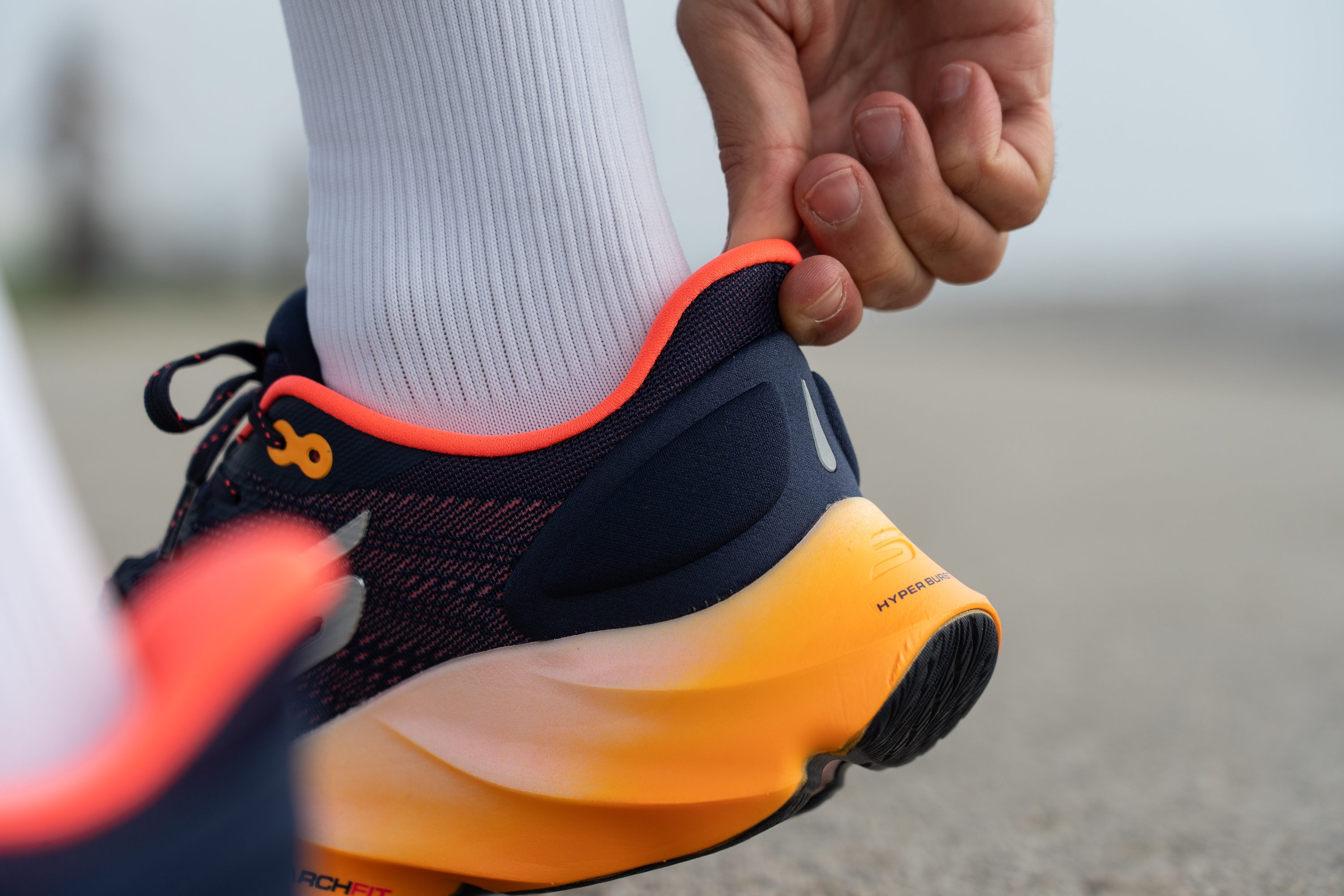
| Aero Burst | Talón extendido |

